Walking the Camino Primitivo: An In-Depth Guide
Articles on this site contain affiliate links, meaning I may be compensated if you buy a product or service after clicking them. The full privacy & disclosure policy is here.When people talk about “the Camino de Santiago,” in general they’re talking about the Camino Frances, a nearly-800km walking trail across northern Spain. There are many other Camino routes, however: you’ll find a dozen or more just in Spain, all finishing at the great cathedral in Santiago de Compostela.
The Frances, while by far the most popular, isn’t the original route. That honour goes to the Camino Primitivo (primitivo means original or first in Spanish), a trail that was first walked by the Spanish king Alfonso II in the ninth century. At the time much of what is now Spain was under Moorish rule, with only the northern part still independent.
Having walked the Frances and Portuguese routes in previous years, it was time for a new challenge. Looking for a challenging but beautiful two- week walk in Europe in fall/autumn, the Primitivo seemed to fit the bill perfectly. Spoiler alert: it very much did.
It’s taken me about as long to write this guide to the Primitivo as it did to walk it, and I’ve broken it up into two main sections, covering planning and the walk itself.
If you’re preparing for your own Camino Primitivo and want to know things like how hard it is, the easiest ways to get to and from the trail, where to stay, distances, costs, and what the food and drink options are like, and other logistical details, read the first part.
If you prefer pretty photos, or want a route summary, daily distances, or a detailed day-by-day description of the walk, check out the second section.
Or, if you’d rather, just read it all!
Planning and Logistics
How Hard is It?
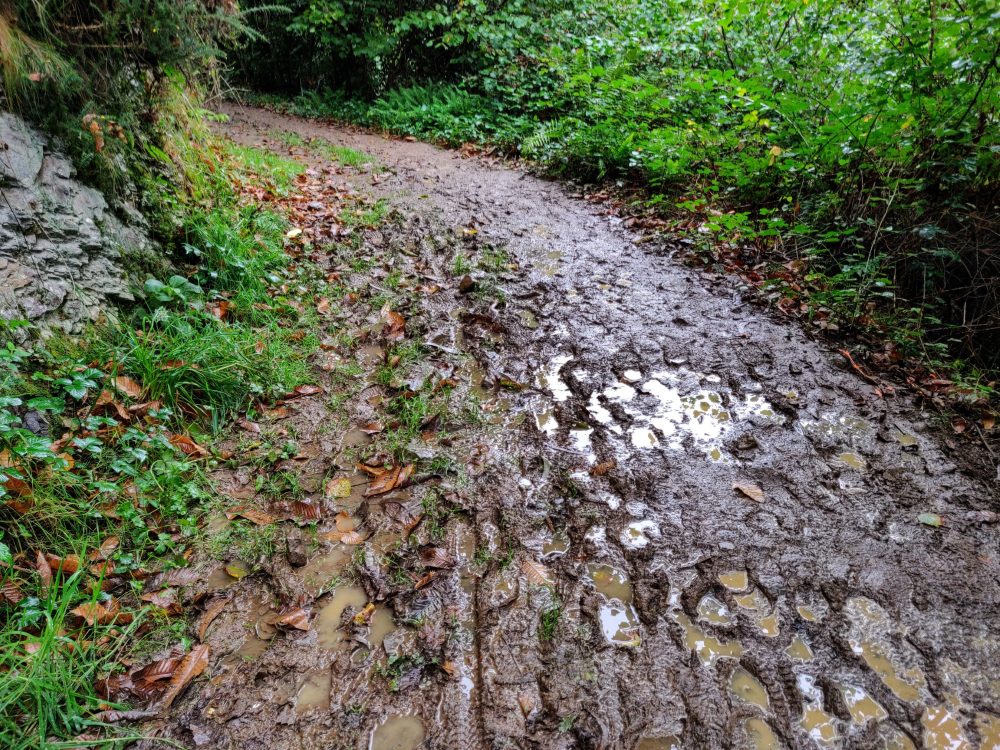
The Camino Primitivo is regularly described as “the most difficult” of the northern Camino routes, but I don’t really agree. Assuming you start somewhere near the French border like most people do, the Frances and Norte routes are both well over twice as long and there’s a lot more road walking as well. For me, at least, that makes them harder overall.
Any given day on the Primitivo, however, is likely to be more difficult than most days on the other routes. Much of the trail runs through the mountains and for a week and a half, if you’re not going steeply uphill, you’re going equally steeply down the other side. The views make it all worthwhile, but you may not believe that at the time.
Combine that with noticeably less accommodation than the other routes, and you’ll often end up having to either walk a sub-15km day or commit to double that. Some days, especially if you take the Hospitales route, you don’t get a choice about it: it’s 25km from one village to the next, with no infrastructure of any sort between them.
That said, there are (usually) taxis and (occasionally) buses that can take you between towns. Once you’re walking, though, you may not be near a road for a few hours. Alternative transport options can be limited if you get tired or injured.
Weather can also be a factor. The Primitivo is generally cooler and wetter than the other Camino routes, with fog and strong winds a factor in the mountains as well. We were incredibly lucky with the amount of sunshine and blue skies we got, but you may well not be.
It’s not just about the discomfort, although there’s definitely that as well. If the weather’s bad enough, there’s a real safety issue on some sections of the route. I’ve never checked the weather forecast on any other Camino as much as I did on the Primitivo!
All of that said, if you’re fit, healthy, and have appropriate gear for the conditions you encounter, you should be able to walk the Primitivo without any real problems. This isn’t hardcore back-country hiking by any stretch of the imagination!
How Scenic Is It?
Compared to the Frances, Portuguese, or the section of the Mozarabe routes I’ve walked, when it comes to scenery the Primitivo is the best Camino by far. The first week in particular was full of spectacular views and beautiful countryside, undoubtedly helped by the unusually good weather we had.
With much further between accommodation, and the villages typically being very small when we did get to them, the forests and mountains often felt devoid of other humans. That was especially true on the Hospitales route (below), where for hours we shared the trail with cows, wild horses, and almost no other people.
Other than walking into Santiago itself, there was virtually none of the trekking through suburbia and industrial estates that marred some days on the other routes, even when entering and leaving good-sized cities like Oviedo and Lugo.
In short, if your hope for the Camino is more time in nature and less time in towns and villages, the Primitivo is where it’s at.
Where Does It Start and Finish?
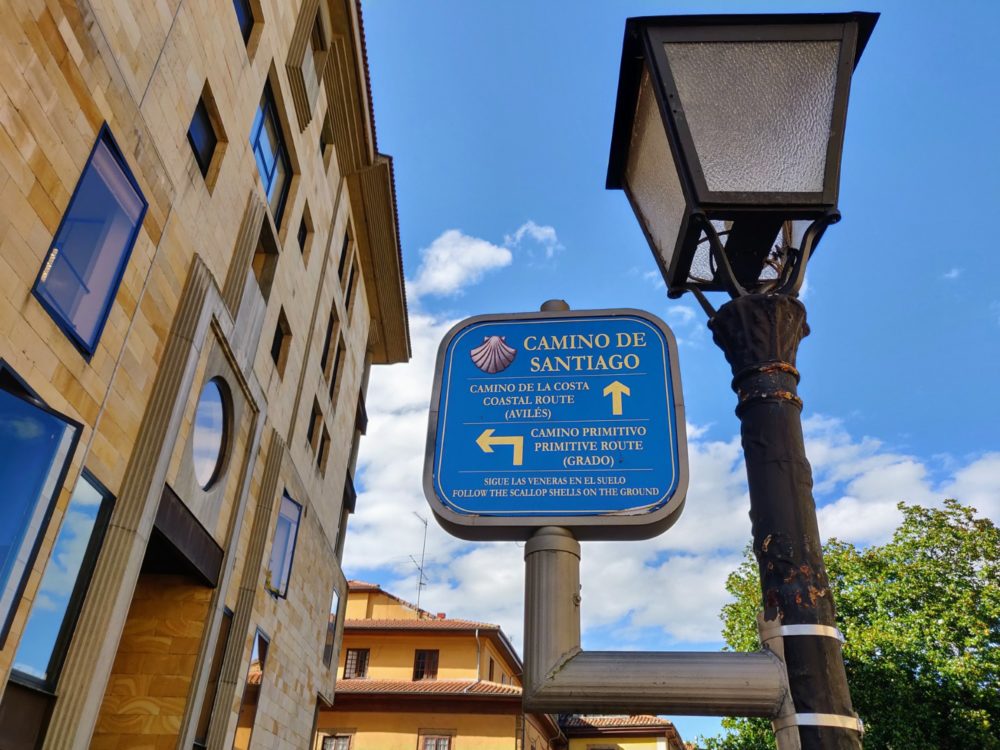
As with any Camino, where you start and finish the Camino Primitivo is really up to you. The “official” route, however, runs roughly south-west from the cathedral in Oviedo, through the mountains of Asturia and the forests of Galicia, to the famous cathedral in Santiago de Compestela.
Along the way, it goes through a few larger towns like Grado, Tineo, and Grandas de Salime, and a couple of cities, Melide and Lugo. The rest of the time, though? You’re walking from one small village to another, often with several hours of trail between them.
How Long Is It?
Between Oviedo and Santiago, the marked route runs for approximately 320km (200 miles) from one cathedral to the other. As with any long-distance trail like this, though, you’ll end up walking more than that.
Finding your accommodation, tracking down food, and any random exploring you have the energy for will all add a bit of extra distance. My Fitbit told me I’d walked a total of 360km by the time I was done, and even though it tends to overestimate a bit, that’s probably not all that far off.
How Well Is It Signposted?
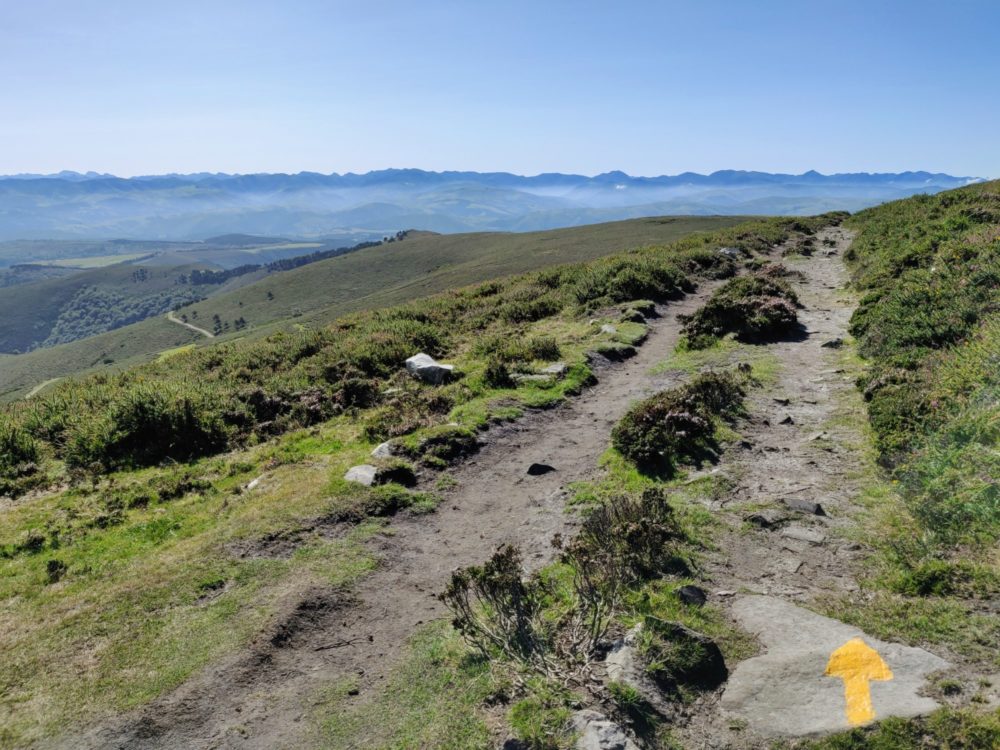
As with other popular Camino routes, the Primitivo is very well waymarked. Between fancy signposts, concrete markers, and the ubiquitous yellow arrows, it’s rare to be out of sight of some kind of route confirmation for more than a few minutes. Basically, whenever you’re walking in daylight and good weather, you’ll rarely go too far off track.
That said, it’s not impossible. Surprisingly, perhaps, this happens most often in the cities, not out in the countryside. Cities like Oviedo and Lugo embed metal scallop shells in the pavement for pilgrims to follow, which are stylish, subtle… and easy to walk straight past when there’s a crowd of pedestrians.
Walking in the dark (which is pretty common, given it doesn’t start getting light until after 7:30am in Spain in mid-September) also adds an extra degree of difficulty. Reflective signs show up in the light of a head torch, but painted arrows? They’re a different story, and you can miss them from a few feet away. Fog has the same effect, and snow buries many of the waymarks entirely in winter.
Long story short? It’s worth having a GPS map of the route on your phone. You’ll rarely need to use it, but it saves stumbling around in the dark or spending half an hour trying to spot invisible metal shells. I used the one in the Buen Camino app, and it worked well.
How Long Does It Take to Walk?
Most people take about two weeks to walk the full length of the Camino Primitivo. That’s an average of about 23km (14 miles) a day, although that average is deceptive: you’ll almost always be walking noticeably more or less on any given day.
My girlfriend and I took 13 days in total, which was a little faster than we’d planned. After a couple of shorter days in the beginning, we walked some longer days toward the end. Sometimes that was by choice, mostly it was just due to the accommodation options or lack of.
Of course, you can walk the Primitivo faster or slower than we did. We met people who were planning to walk it in as little as eight days, and others who’d taken the better part of three weeks. Anything less than about 10 days will be tough and needs good fitness, decent weather, and no injuries to achieve.
If you’re short on time, you’re better off walking part of the route rather than trying to crank out huge distances every day. You could walk for a bit over a week and finish in Lugo, for example, or even start there and just walk the last 100km.
Is It OK to Walk It Solo?
While I walked this Camino with my girlfriend, I’ve done the others solo. Or at least, solo for the first day or two until I started making friends along the trail or in restaurants and albergues at the end of the day. While I could always spend time alone when I wanted it, it was very rare for there not to be an English speaker to chat or have a meal with each day.
The demographic was a bit different on the Primitivo, at least during the two-week period that we were walking it, with more groups of Italian and especially Spanish friends and family. Locals have started to walk routes like the Primitivo more frequently to get away from the summer crowds on the Frances, and that was the case in early to mid-September as well.
If you speak Spanish or Italian, you’ll likely have a solid group of people to walk with by the end of the first day. That was certainly the case for some Spanish-speaking friends of mine who walked the same route a couple of years earlier.
Our Spanish is barely-functional at best, certainly not good enough to be holding down conversations with native speakers. Coupled with comparatively low numbers of walkers overall, it took us a bit longer to meet people. Even so, we’d made a few acquaintances by the end of the first week, and had a solid Camino family by the time we got to the cathedral.
Getting To and From the Trail
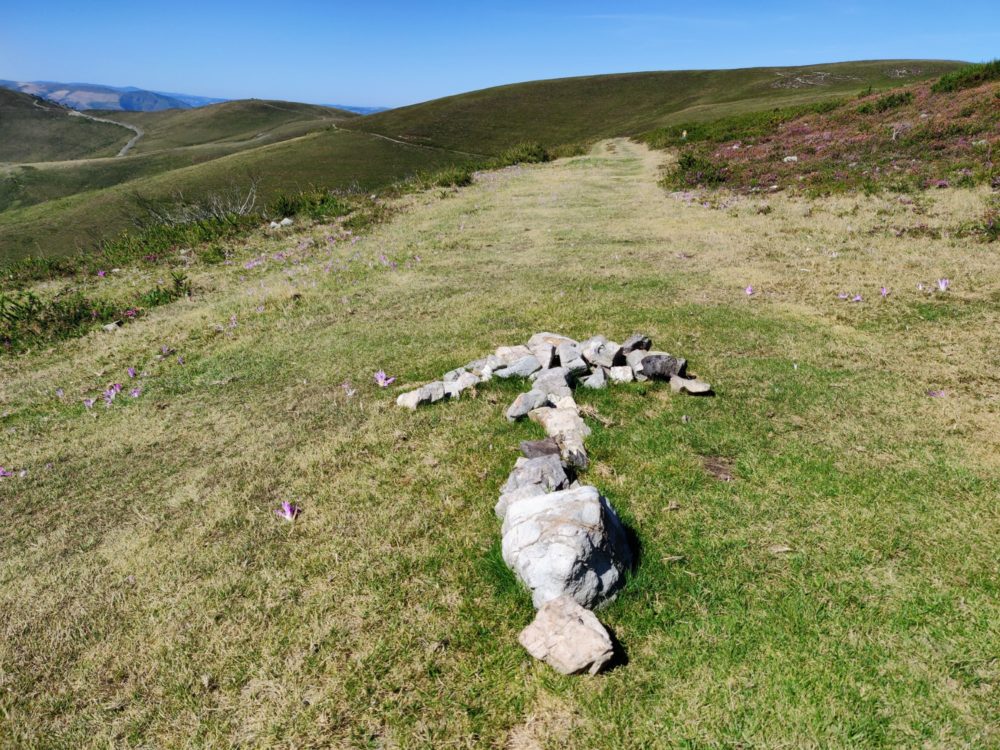
Getting to Oviedo isn’t difficult. The nearest airport (Asturias) is on the coast about 30 miles north of the city, and buses run roughly every hour for much of the day. You may sometimes find a direct flight from the UK and other nearby countries, but otherwise you’ll be more likely to go via Barcelona or another large Spanish airport.
Long-distance train and bus services also run to Oviedo. The terminals are beside each other, within easy walking distance of the city centre. We’d spent a few days in the Basque country before starting the Primitivo, and took an ALSA bus from San Sebastian along the north coast to Oviedo. It took around 6.5 hours, and cost 27€ per person when booked three weeks in advance.
Getting back from Santiago is even easier. Flights depart regularly for other airports in Spain and several European countries. Long-distance trains and buses will also take you anywhere in Spain you’d like to go, albeit perhaps with a layover or two along the way. ALSA buses also run south to Porto and Lisbon in Portugal, with several stops along the way.
Public transport along the Primitvo route is relatively sparse, although it does exist. Lugo is reasonably well served, for example. If you want to get on or off the route somewhere else, it may require a taxi to the nearest larger town or city.
Bag Transport
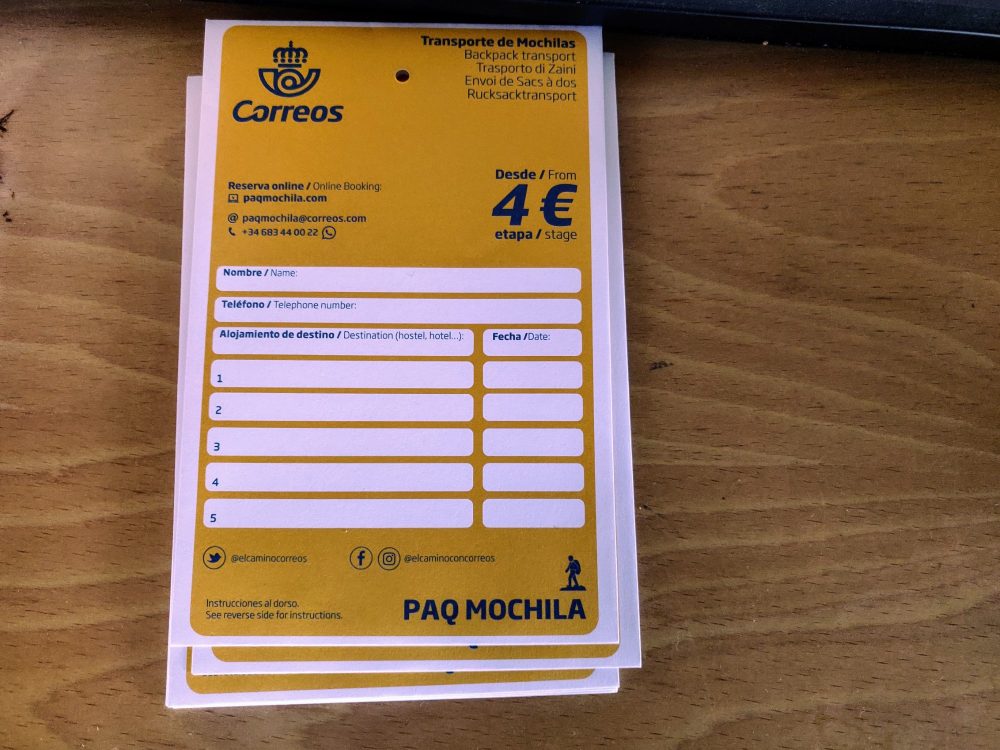
We carried everything we needed for the Primitivo in our backpacks, but you don’t have to. The Spanish postal service (Correos) offers bag transportation services, where your pack gets collected from your accommodation each morning and dropped off at your intended destination before you arrive.
Hiking with just a daypack holding little more than water, snacks, and a jacket would certainly make life easier. Since you’re more likely to be booking your accommodation in advance on the Primitivo than some other Camino routes, this approach could work pretty well if it’s something you’re looking for.
Pricing is quite reasonable, from 4€ per bag per day if you’re booking several stages or an entire route. You can book your transport online or via email, phone, or WhatsApp the day before, and at least some of the albergues have forms like the one shown above that you can use as well.
Weather
Moreso than on many other Spanish Camino routes, the weather on the Primitivo can be unpredictable at any time of year. Because the first half in particular winds through the mountains, there’s a decent chance of fog, rain, and cool weather even when it’s bright sunshine elsewhere in the north of the country.
We walked during the first half of September, and were extremely lucky. There were only a couple of days where it rained, and even then it didn’t last the entire day. The rest of the walk was spent largely under blue skies and bright sunshine, although there was often some fog around in the morning.
Even the Hospitales detour, where you climb to 1200m and spend hours walking along an exposed ridgeline, was gloriously sunny. Windy, yes, but blue skies as far as the eye could see.
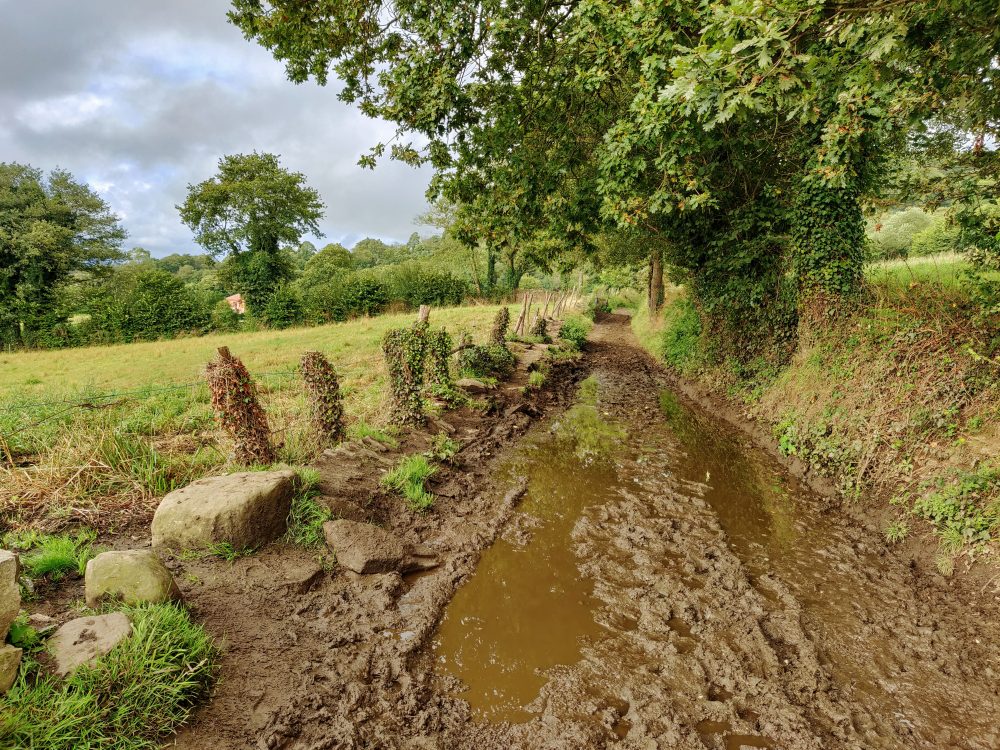
That said, what rain there was didn’t seem to drain away particularly quickly. If you like mud, rest assured, you’ll get plenty of it. If you don’t like mud, well, you’ll still get plenty of it. Especially if it’s rained recently, don’t expect clean boots at the end of the day.
It rarely got uncomfortably hot, even on the days we were walking late in to the afternoon. That’s a stark contrast to the other routes I’ve walked in Portugal and northern Spain at the same time of year, and a welcome one. It wasn’t until we descended from the mountains and joined the Frances route for the last couple of days that the heat became a factor.
You, of course, might not be so lucky with the weather. Warm clothes and a good waterproof layer are mandatory on the Primitivo, no matter what time of year you’re walking. It’s the only Camino route I’ve walked so far where I seriously considered taking waterproof boots. I’m glad I didn’t in the end, but would have a very different opinion if I’d had a week of rain!
Accommodation
While there’s plenty of accommodation in Oviedo, Lugo, and Santiago, options diminish quickly elsewhere and can fill up fast. I’m a firm believer in not booking ahead on the Camino since it eliminates the spontaneity that makes it so enjoyable, and yet by the midpoint we were booking rooms just like everyone else.
Why? Well, it had a lot to do with spending half an hour tracking down the very last room in Berducedo, having just walked 33km over the mountains to get there. The next town was apparently full as well, just to add to the urgency.
Even so, I dug my heels in about making bookings until a couple of days later. Just after lunch we were the first to arrive at a nice-sounding albergue in Fonsagrada, only to be told that every bed in the place had been reserved in advance. This was in the second week of September, theoretically after peak season was finished.
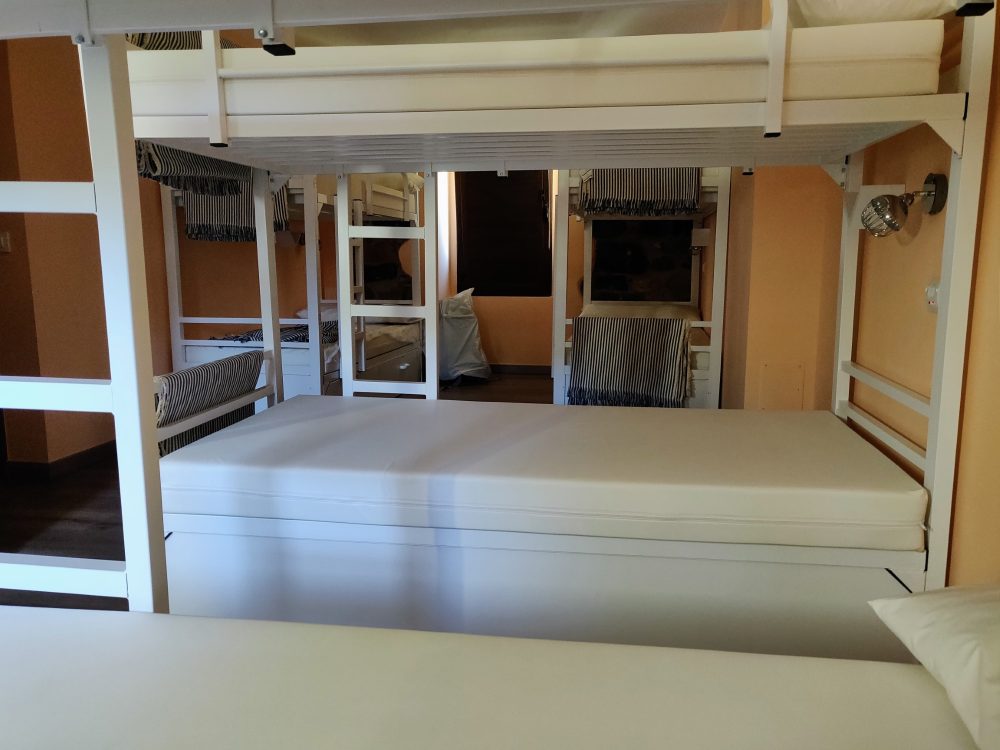
While finding a room wasn’t always easy, what accommodation there was was mostly pretty good. A few new albergues have been built in the last couple of years to cater for the increasing number of people walking the Primitivo, so hopefully the current shortage is somewhat temporary.
We stayed in a mix of municipal and private albergues, both dorms and private rooms, as well as pensions, hotels, and a monastery dating back to the 11th century. Per-person prices ranged from 5€ in the monastery to 35€ in a fancy hotel in Lugo.
As a general guide, expect to pay 5-7€ for a dorm bed in a municipal or religious albergue, 10-12€ for a dorm in a private albergue, and 17-25€ per person for a double room in an albergue or pension.
You’ll find some accommodation listed online on Booking.com, and we booked a couple of places that way. If your Spanish isn’t great, that’s probably the easiest way to do it when you can.
If booking online isn’t an option, it’s time for a phone call. I was usually able to make myself understood with my kindergarten Spanish, thanks more to the patience of the person on the other end of the line than my language skills. If you’re really not confident about it, just ask the person at your previous accommodation if they’d be happy to call on your behalf.
I go into more detail about each place in the day-by-day summary below. For the sake of having an accommodation list in one place, though, here’s everywhere we stayed along the Camino Primitivo with a link for more information where possible.
- Day 0: Hotel Rosal, Oviedo
- Day 1: Villa Palatina, Paladin
- Day 2: Monastery of San Salvador, Cornellana
- Day 3: Albergue El Texu, La Espina
- Day 4: Casa Herminia, Campiello
- Day 5: Hostel Rural Camin Antiguo, Berducedo
- Day 6: Municipal albergue, Grandas de Salime
- Day 7: Casa Manolo, Fonsagrada
- Day 8: Albergue San Mateo, Cadabo
- Day 9: Puerta de San Pedro, Lugo
- Day 10: Albergue O Candido, San Romao
- Day 11: Albergue Pereiro, Melide
- Day 12: Pension ‘The Way’, A Brea
- Day 13: Stellae Luscofusco, Santiago
Apps and Guidebooks
Printed guidebook options are rarer for the Camino Primitivo than the more popular routes. The (in)famous Brierley guidebooks so beloved of English speakers on other Caminos don’t cover the Primitivo, so your best option is the Camino del Norte and Camino Primitivo guide from Cicerone.
Having been happy with app-based guides on other Caminos, though, I didn’t bother with a physical one for the Primitivo either. As with the books there aren’t many electronic guides available, but a few do exist.
I tried out a few different apps before leaving, and settled on Buen Camino (Android/iOS). I also saved a few online guides to my phone as PDFs, but didn’t really end up using them. The app covered all of my needs, from food, drink, and accommodation to distances and GPS maps.
It was straightforward to edit the suggested daily stages to suit ourselves, and to figure out how far we’d have to walk each day. Information was largely up to date, albeit with the occasional price change or new albergue that hadn’t made it into the app yet.
A word of warning, though: Buen Camino was great at the time (September 2019), but a major update since then has made it less reliable, at least on Android. Using it again while writing this post, it worked fine on one of my phones and barely at all on the other. If you’re planning to rely on it, my advice is to test it out thoroughly before you go.
While you’ll be able to rely on Wi-Fi being available in most albergues and some bars, being able to get online while you’re walking helps with everything from loading maps to booking your next albergue.
Cell service is good along most (not all) parts of the Primitivo. Unless you’ve got free or very cheap roaming with your home cell company, picking up a Spanish eSIM before leaving home or local SIM card when you arrive will save you a bunch of money.
Food and Drink
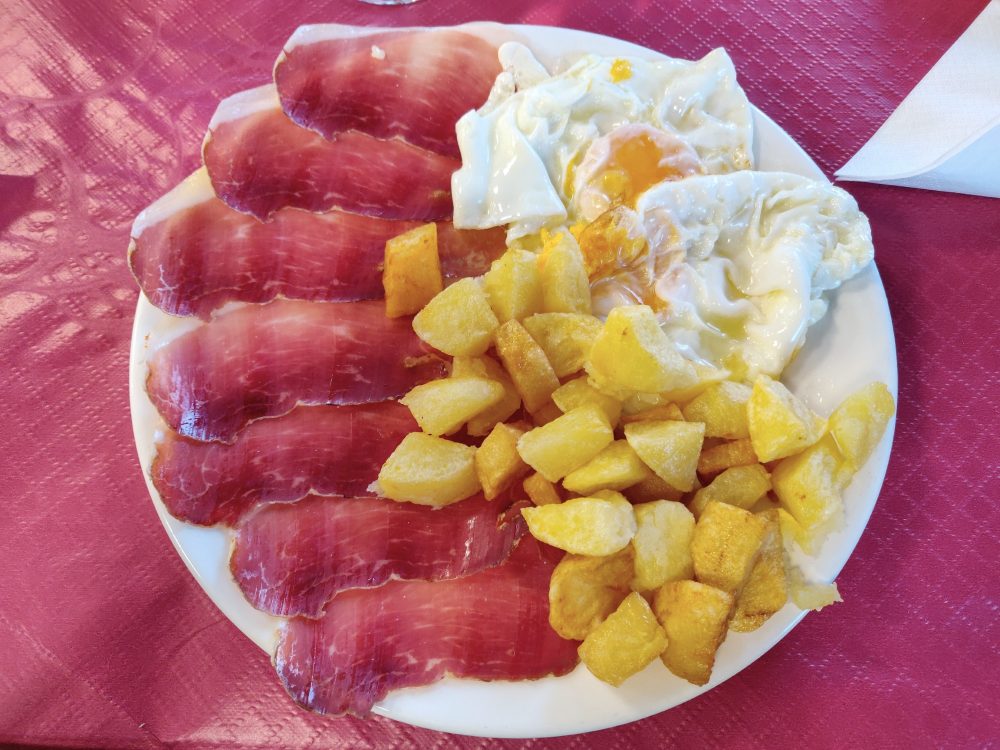
I’m not going to lie: as great as the Primitivo was in many ways, the food outside the cities was not one of them. We ate well in Oviedo, Lugo, Melide, Santiago, and occasionally elsewhere, but in general the meals were a method of replenishing the calories we’d burned that day and not much more.
Walkers (especially vegetarians and vegans) complain about the food on every Camino route, but in my experience at least, it was a little fresher and more varied on the Frances and especially Portuguese routes than on the Primitivo.
Restaurants and bars in small villages in rural Spain don’t always have the resources available to whip up wonderful meals at the drop of a hat, especially if they’re only getting a handful of walkers eating there each day. Stale bread and soggy chips were a staple, usually with some kind of protein in the form of chicken, pork, or as we got closer to the coast, seafood.
Menus de peregrino (pilgrim menus) weren’t always available, especially in the very small villages, but provided good value for money when they were. As with every other route I’ve walked in Spain, drinkable wine was always provided in large quantities for very little money. Another good reason to walk a Camino!
Breakfasts consisted of whatever happened to be available. Tortilla española was fairly common, but sadly my staple pan con tomate from earlier Caminos was rarely on the menu. Sometimes, it was just a shot of espresso and a piece of yesterday’s fruit. That said, if you like pastries, you’ll usually have more options. My body doesn’t tolerate cow’s milk, so I took to keeping a bit of extra food in my bag instead just in case.
Lunch was, more often than not, a bocadillo. Occasionally this was a delight, huge chunks of fresh baguette full of fresh salad and ham, tuna, or pork loin. Most of the time, however, it was… not so delightful. Now and then we’d find a great little bar or restaurant to stop at for lunch, and took full advantage. In general, though, the long, luxurious lunch breaks of my other Caminos were a distant memory.
Once we hit Melide (home to the best Galacian-style octopus I’ve eaten anywhere) and joined the Frances route for the final stretch into Santiago, the food options and quality noticeably increased in proportion with the number of other walkers.
Packing List
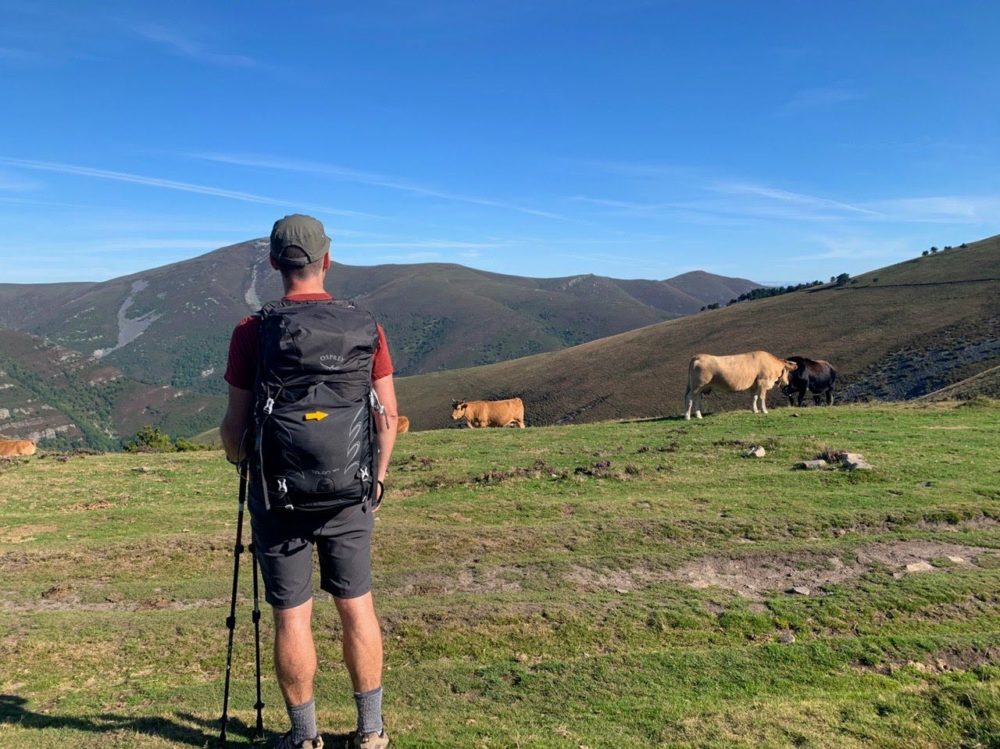
Even though I’d walked most of my other Caminos in September as well, I still put a bit of thought into my packing list for the Primitivo due to its reputation for long days and bad weather.
As mentioned earlier, I seriously considered buying waterproof hiking shoes (most likely the waterproof version ) of the Merrell Moab 3 that I usually wear, but didn’t bother in the end. At the end of a couple of the long, hot days toward the end in particular, my feet were thanking me for the extra ventilation.
In the end, the changes I made from earlier Caminos were quite small. My long-sleeved Icebreaker merino top was starting to wear out anyway, so I bought a slightly thicker version of the same thing. I also swapped out the flip-flops I usually wear at the end of the day for some lightweight travel sneakers, replaced my sleeping bag and water bottle, and bought a different brand of socks.
I try to keep my bag under about 10% of my body weight. For me, that means everything I need to stay safe and comfortable, including water and snacks, needs to come in under 7-8kg. I managed that on the Primitivo, but only just. My backpack was the Osprey Talon 44 that I’ve reviewed separately in the past, and it was ideal.
Rather than recreating everything here, I just updated my Camino packing list instead. It’s been a work in progress over the course of a thousand miles, tweaked and modified after each Camino, and I think it’s pretty close to a final version now. I guess we’ll see after I walk the next one!
Finally, don’t forget travel insurance. While most pilgrims suffer little more than a few blisters and the occasional bruise or scratch, a small minority end up with more serious illness and injuries, and hospital bills and replacement flight costs can mount up very quickly.
I’ve used many different providers over the years, but these days generally start with Heymondo. I’ve found them to be an affordable and reliable option, whether I’m only after medical cover or want a policy that handles things like theft and damage, missed flights, and lost luggage as well. Compared to some of the others, the website is refreshingly simple and does a good job of explaining exactly what I’m buying.
Costs
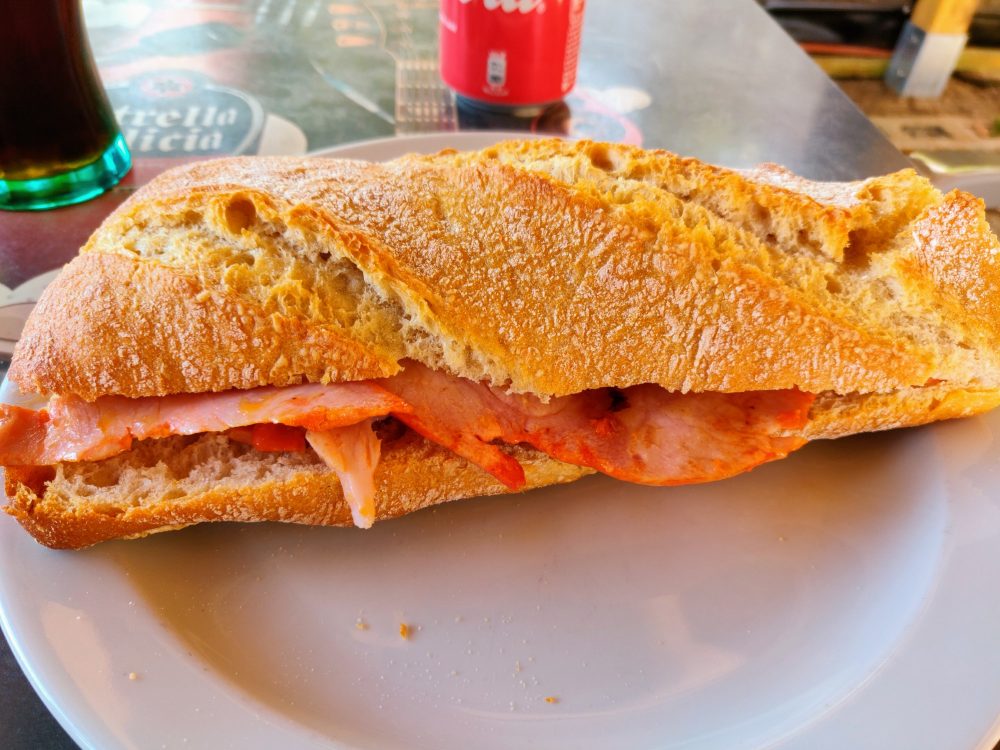
Like most of the other Spanish and Portuguese Camino routes in particular, the Primitivo can be walked very cheaply. You could set yourself a daily budget of 20€ and stay inside it quite easily, as long as you were happy to stay in a municipal or parochial (ie, religious) albergue whenever you could and self-cater some of your meals.
Likewise, you could easily spend double or triple that if you stay in private rooms or hotels, dine at higher-end restaurants, and enjoy plenty of the local vintage along the way. While it’s very possible to walk the Camino on a tight budget, it’s not a given that you will.
Other than your gear, the only cost you’ll incur before you start walking the Camino is your credential, or pilgrim passport. Stamps in this cardboard booklet mark your progress, and if you want a completion certificate from the pilgrim office in Santiago, you’ll need a pilgrim passport with one or two stamps per day for at least the last 100km of your route.
Many albergues, especially municipal ones, will also ask to see your credential to ensure you’re actually walking or biking the Camino and not just wandering in off the street. Any accommodation aimed at walkers will have a stamp, as will many bars and cafes along the way and even some roadside chapels and other buildings.
You can order a credential online from various sources, but I’ve never bothered. Assuming you begin from a major city, you’ll be able to pick one up from the cathedral that marks the start of the route. The Primitivo is no exception: we bought ours from the ticket office inside Oviedo Cathedral, for the princely sum of 2€ each.
As a rough guide, breakfast will typically set you back a couple of euros for a pastry and coffee, and a bit more if you have tortilla and/or orange juice. A bocadillo and soft drink, beer, or wine for lunch usually costs around 5€, and a menu de peregrino is about 10€ for three courses (starter, main, and dessert) plus wine or water.
As a result, if you’d prefer to eat out for every meal, not be too concerned about an extra cup of coffee or glass of wine here and there, and stay in private albergues more frequently, expect to spend 25-30€/day. Dorm beds usually cost 5-15€ depending on how new the albergue is and whether it’s privately-run or not.
Private rooms, on the other hand, typically costs anything from around 30€ at the low end (small single room with a shared bathroom in a municipal albergue) to 40-50€ for a double room in a pension or private albergue. Hotels may cost a bit more, and on the Primitivo you’ll really only find them in the cities.
Don’t expect single rooms to be available in all (or indeed, many) albergues or pensions, but double, twin, and triple rooms are more common. Some places offer a single occupancy rate for a twin room that’s a little cheaper.
My daily costs varied more on this Camino than others I’ve walked, primarily because it was the first one I’ve walked with my girlfriend. In the past I’d stayed almost entirely in dorms, but we splashed out on private rooms about two-thirds of the time on the Primitivo. Sometimes that was by choice (more sleep is good), sometimes it was by necessity when they were the only beds left in town.
The least I spent on any day was 17€, and the most was 63€ thanks to a big celebratory meal with friends in Santiago . The average per day was 39€.
The Walk Itself
All distances mentioned below are approximate. They were recorded on my Fitbit, which doesn’t use GPS and usually over-estimates mileage a bit. You can probably take 5% or so off the listed numbers.
- Day 1: Oviedo to Paladin, 22km
- Day 2: Paladin to Cornellana, 20km
- Day 3: Cornellana to La Espina, 23km
- Day 4: La Espina to Campiello, 26km
- Day 5: Campiello to Berducedo, 33km
- Day 6: Berducedo to Grandas de Salime, 24km
- Day 7: Grandas de Salime to A Fonsagrada, 27km
- Day 8: A Fonsagrada to Cadabo, 26km
- Day 9: Cadabo to Lugo, 30km
- Day 10: Lugo to San Romao, 20km
- Day 11: San Romao to Melide, 28km
- Day 12: Melide to A Brea, 28km
- Day 13: A Brea to Santiago, 26km
Day 0: Oviedo
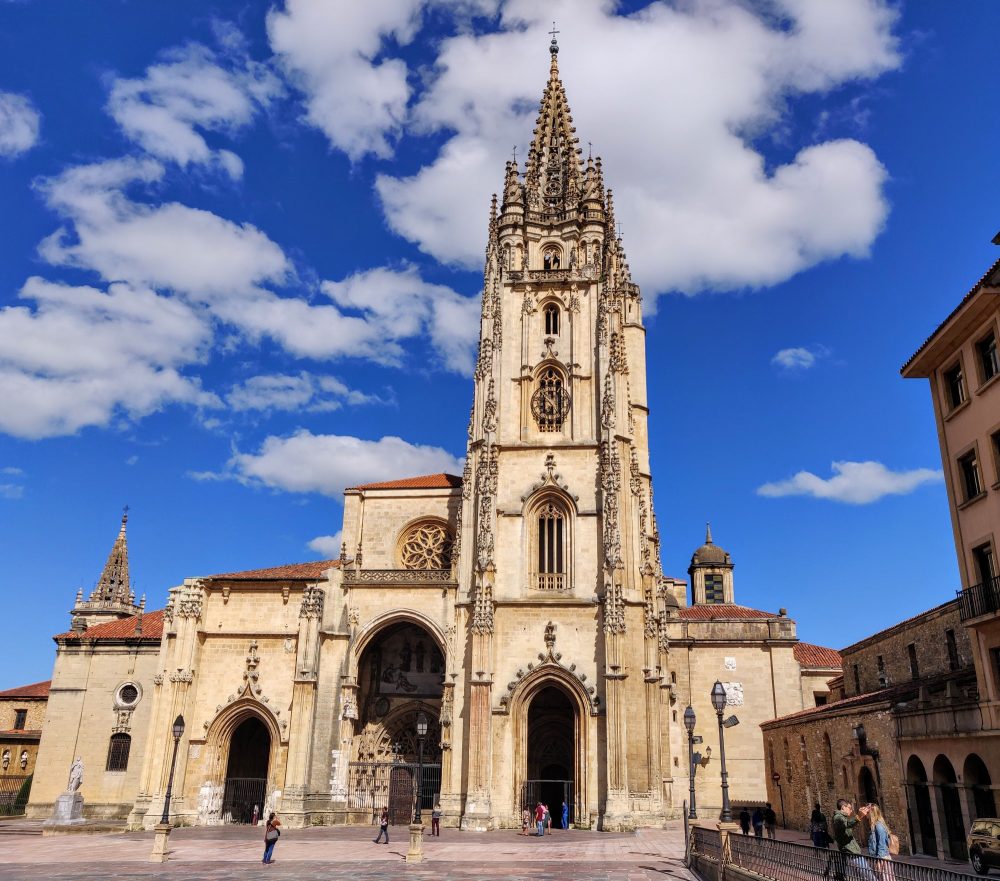
Arriving mid-afternoon after the lengthy bus ride from San Sebastian, we only had a few hours to explore Oviedo. It’s an attractive little city, especially in the old part of town, with some beautiful stone buildings and spacious town squares.
Ditching our bags at our accommodation (the modern and spotlessly-clean Hotel Rosal), the first stop was the nearby cathedral. We needed to pick up our pilgrim passports, and it made more sense to find the start point when we had plenty of time that afternoon than hurriedly the next morning.
That process took about three minutes, after which we spent the next couple of hours wandering around enjoying the sunshine and trying to find anywhere serving food and wine for an early dinner. Of course, “early dinner” by Spanish standards is about 8pm, so while the the wine wasn’t hard to track down, the food took a bit more work.
We eventually ended up at Sidrería Tierra Astur Parrilla, which as the name implies, specialises in the local cider that the Asturias region is renowned for. Typically poured into the glass from above the waiter’s head, it’s no surprise the floors in these establishments are wooden and easy to mop down.
The cider was unusual and tasty, the food was heavy and meat-based, and there was more of both than two average-sized humans probably needed. The perfect preparation for two weeks of hiking, I guess!
We’d planned to explore more of the city after dinner, but with bellies full of food and a cold wind cutting through the evening sunshine like a knife, our feet carried us back to the hotel without bothering to discuss the idea with our brains first. Tomorrow, we’d walk!
Day 1: Oviedo to Paladin
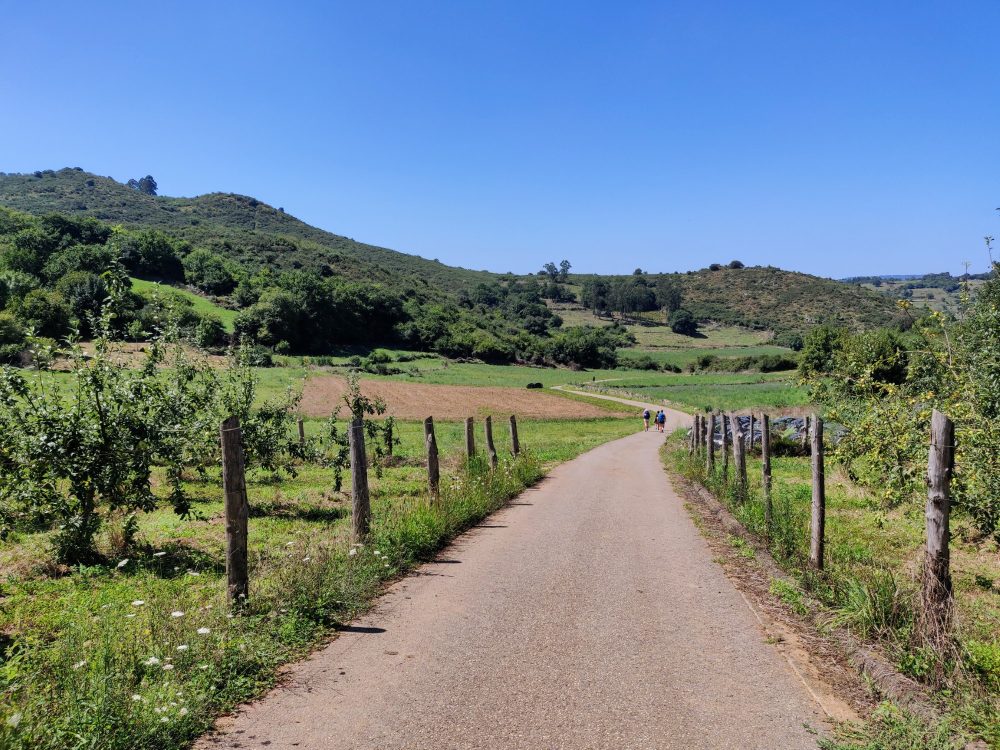
After a quick breakfast of coffee and pinchos at a nearby bar, we posed in the chilly morning mist for a couple of photos outside the cathedral, glanced up at the sign pointing toward Santiago, and set off.
Someone in Oviedo had the foresight to embed metal shells in the pavement to mark the route out of town, which worked wonderfully for about three minutes until we missed one and ended up wandering aimlessly through the city past well-dressed men and women on their way to work. Great start, Dave.
Back on track, we picked up a couple of other walkers who were both starting their first Camino, and together our small group headed west. It didn’t take long to leave what passed for suburbia behind, the mist burning off as we had our first coffee stop at a small bar a couple of hours later.
We made good time into Escamplero: too good, in fact, as the only bar in town that was open that day didn’t start serving food until the better part of an hour later. Oh well, any excuse for a long lunch break and a couple of large glasses of wine in the sun, I guess.
We’d toyed with the idea of staying in Escamplero that night, but refreshed after our endless lunch and with plenty of time left in the day, we chose to keep going. Perfect blue skies and some lovely woodland trails rewarded that decision, and it wasn’t until right at the end that we had any real road walking.
Villa Palatina was virtually brand new, and one of the nicest private albergues I’ve stayed in on any Camino. It’s hard to complain about anything when you’re sitting on a grassy lawn enjoying a kalimotxo (red wine and Coke over ice…don’t knock it til you’ve tried it) in the last of the afternoon sun.
With no other accommodation, bars, or restaurants around, dinner was at the albergue. Fortunately it was delicious, with grilled sardines the highlight. Another drink and bed by 10pm, just in time for the snoring to start from the neighbouring bunk. It wouldn’t be a Camino without it.
Total distance: 22.3 km (13.8 miles). Bed in 8-person dorm: 15€
Day 2: Paladin to Cornellana
Rising suitably unrefreshed, we grabbed a light breakfast at the albergue bar and headed out into the mist once more. With only a short day planned, there was no rush, and we ambled along beside the river toward Grado and second breakfast.
The highlight of this stretch was undoubtedly the Asturian horses galloping wildly around a little paddock just outside town. Look at those tiny chonky boys!
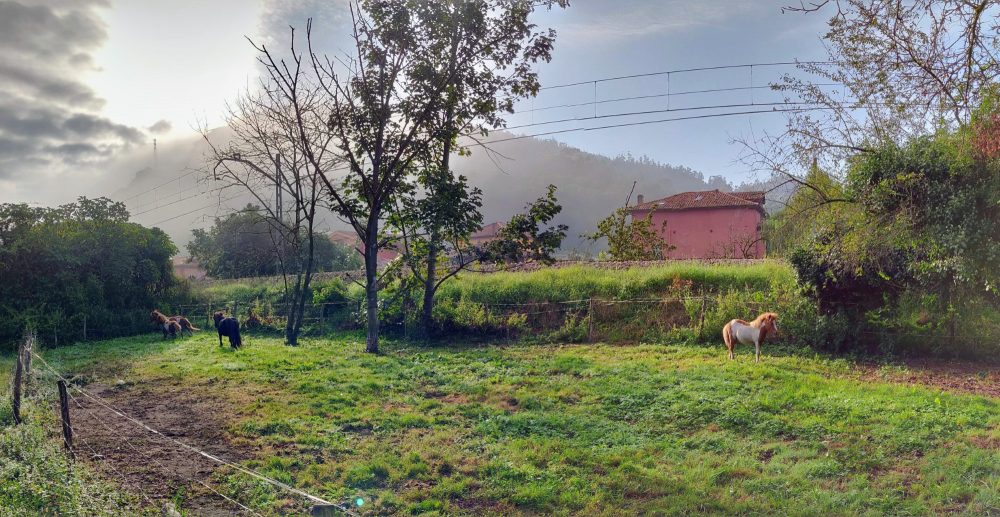
That was definitely more of a highlight than what lay in store on the other side of Grado: a long, hot uphill slog. As usual, though, the views almost made up for the sweat and sore feet. That’s what I was telling myself, at least.
The descent on the other side of the hill was nearly as steep, and I found myself speeding down the cracked concrete roadway. Probably a good thing, really, as it didn’t give me time to think about the small snake on the side of the road as I passed it at a near-jog. At least it was dead. Probably.
Ambling into Santa Eulalia at the bottom of the hill, I was hoping for food and ended up settling for a warm Coke at a table in what looked for all the world like an extension of someone’s living room, but was advertised as a bar and albergue. It was, of course, all three.
Mildly unnerved by the unyielding stare of both the owner and the solitary other customer who looked like he’d been sitting there since Alfonso II himself wandered these parts, we kept going. It was only another 3km through some pretty woodland to the 11th-century Monastery of San Salvador in Cornellana, our planned stop for the night.
We were one of the first to arrive, and after paying our 5€ donation and being pointed to a dorm full of empty bunks, we headed back out past the crumbling walls to track down lunch. The minimal menu at La Taberna promised little, but the huge plate of roast chicken and chips turned out to be surprisingly delicious. Or maybe we were just starving.
The delights of Cornellana didn’t take long to explore, but we dragged them out until we could join the locals and few other walkers for 1€ buckets glasses of wine in the evening outside a bar on the main street. Not a terrible way to end the day.
Total distance: 20.1 km (12.5 miles). Bed in a 12-person dorm: 5€
Day 3: Cornellana to La Espina
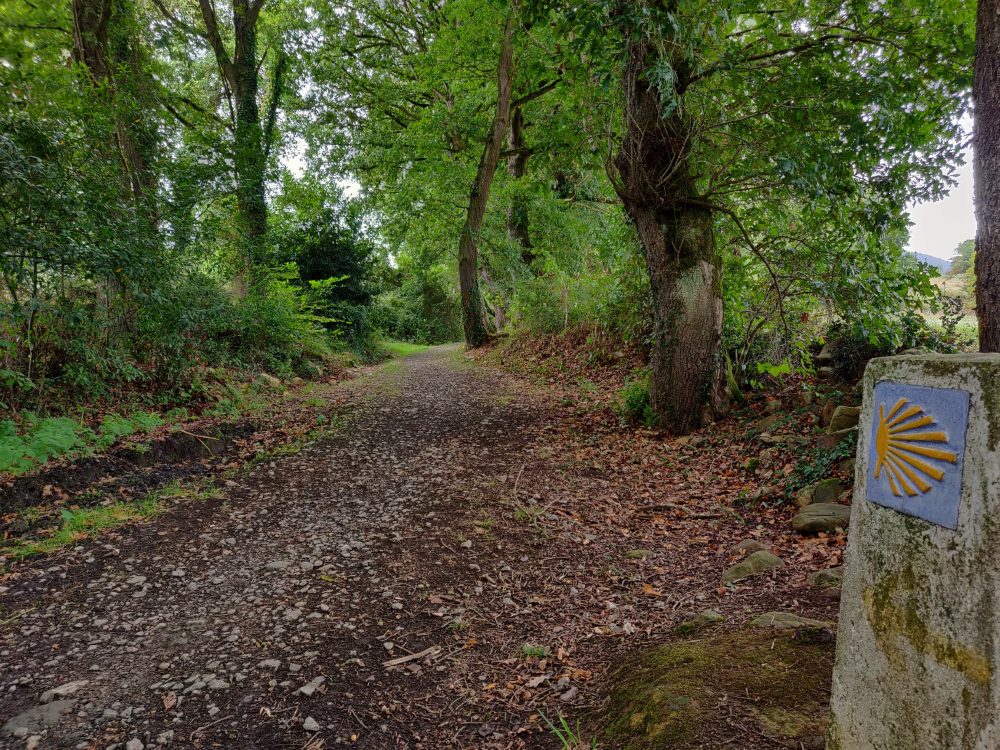
Perhaps it was the religious setting, but a Camino miracle had delivered a shocking lack of snorers overnight. Waking up with the sun instead of a stranger’s nasal symphony is a rare treat in any albergue, and I savoured every non-waking minute of it.
We walked the five minutes back to the main street for breakfast, and set off under clearing skies…straight up the side of a mountain. Lung-busting climbs were already becoming a theme of this Camino, but so were the views and lack of road walking, so no complaints from me. Not that I had the breath for them anyway.
There was nowhere to stop until Salas, over 10km away, but those dirt trails and cool temperatures meant the miles passed quickly. It had been slowly clouding over as we walked, though, and by the time we finished our uninspiring baguettes for lunch, the rain was starting to fall. It wasn’t heavy, but it was persistent. Time to break out the Quasimodo poncho.
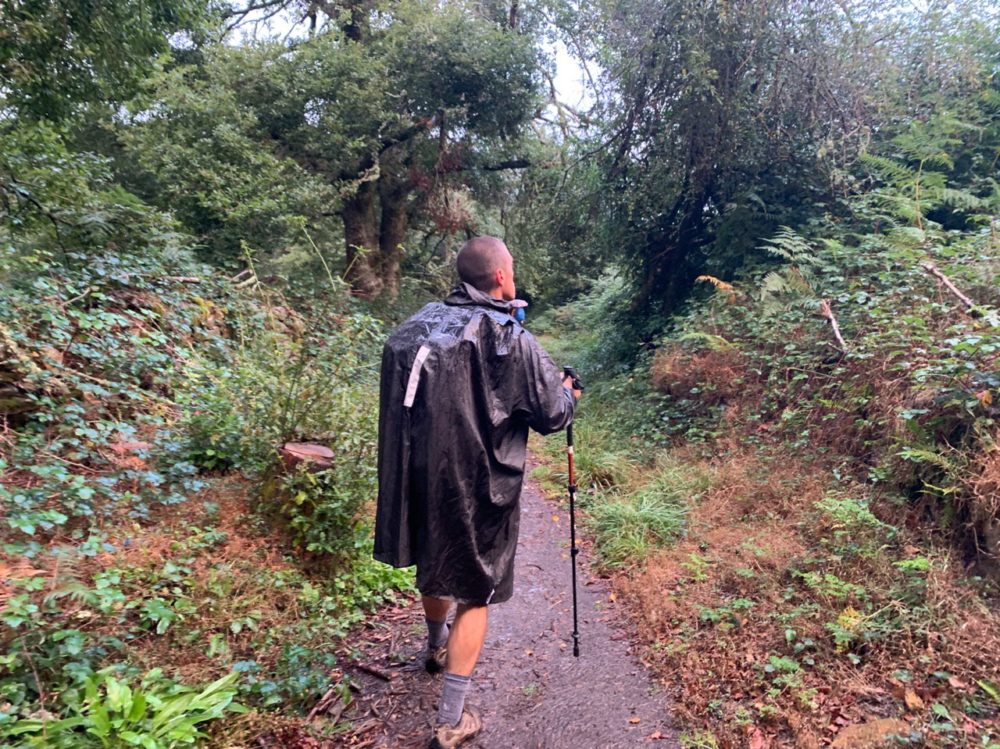
With the rain came the hills, and it was a slow, steady, and damp trudge for the next couple of hours. The views would have been lovely on a clear day, but this wasn’t one. Not that we really had much chance to look at the views anyway: avoiding the worst of the mud was a bigger priority.
The rain slowed to a drizzle as we entered La Espina, which seemed as good a place as any to stop. The town didn’t have much going on during a drizzly Thursday afternoon in September, but we found an open bar at the end of town where we could watch the rain fall and sip wine for an hour or two.
Accommodation for the night was at El Texu, a nice, homely albergue run by a lovely Polish woman named Kaisa who offered a home-cooked dinner to us and the group of Italian friends who’d come in shortly after us. We’d end up crossing paths with them most days for the rest of the walk.
The albergue had a grassy seating area out the front that would have been lovely on a sunny day, and a fridge stacked with beer, wine, and soft drinks paid for via an honesty box. Despite the weather, it was my kind of place!
Total distance: 23 km (14.3 miles), bed in 18-person dorm: 10€
Day 4: La Espina to Campiello
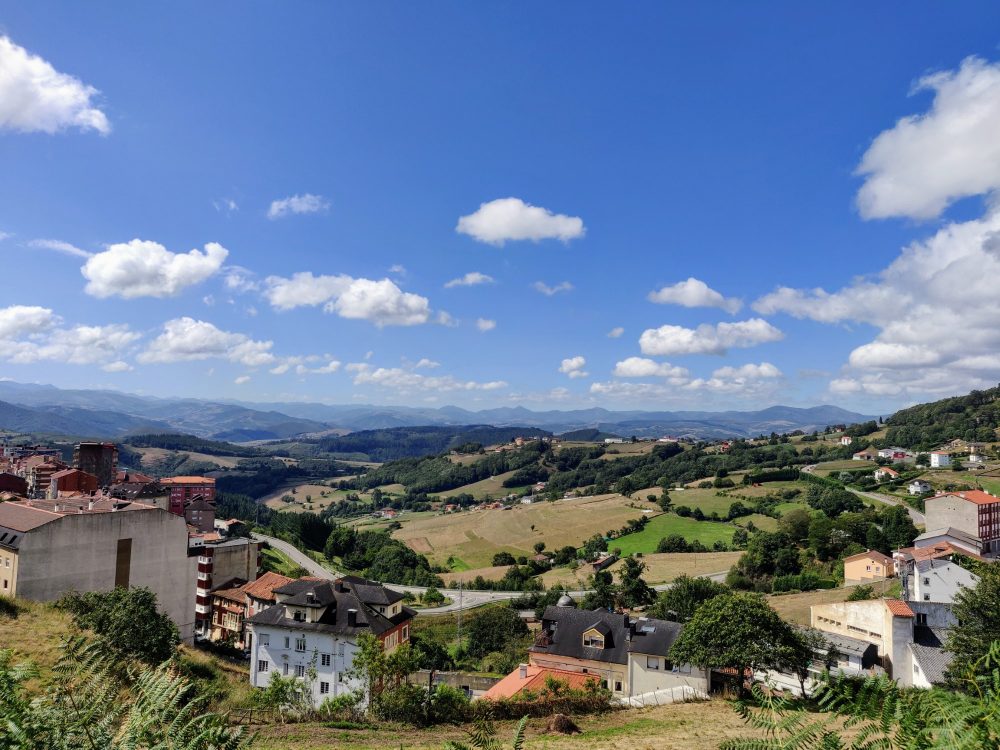
My diary note for the morning reads “Snoring all night, alarms at 5 and 5:30am, bag rustling for two hours: welcome to the Camino.” There’s nothing more to add.
After breakfast at a nearby bar, we dragged our tired bodies out of town under overcast skies. It had rained again overnight, and the muddy trails of the day before were now definitely more mud than trail. Luckily the cold wind soon blew the clouds away, and we were hiking under sunny skies again by mid-morning as we climbed ever-higher.
The views were incredible, and combined with the sunny but cool weather, made this one of the better days of walking I’ve done on any Camino. There were no towns or villages for the first 11km, but the pace was pretty quick once we got past the muddy sections of trail, and we found ourselves descending into Tineo right on lunchtime.
Bar Tineo was an unexpected gem. A little restaurant with all the ambiance of a church hall, we chose it primarily because it was open. The owner wisely gave up on trying to understand my appalling Spanish, and instead just ushered us to a table, gave us water and wine, and motioned for us to wait.
Ingredients came and went from the kitchen, clattering of dishes ensued, and out came some of the most delicious fish soup I’ve ever had the pleasure of eating. Paired with baskets of bread beforehand and platefuls of fried chicken afterward, we definitely weren’t hungry by the time we were sent on our way an hour later. 10€ well spent!
The trail kept rising, the weather and views kept improving, and the afternoon flew by. The last 3km along the road into Campiello were a bit of a slog on what was now a pretty warm afternoon, but all in all it had been a fantastic day of walking.
After the lack of sleep of the night before, we opted for a private room at Casa Herminia. There are only a couple of albergues in Campiello, and Casa Hermiana was definitely trying to be a one-stop pilgrim shop. It offered everything from meals, drinks, and accommodation to groceries, hiking equipment, souvenirs, and whatever else your hiker’s heart desired.
After the usual go-round of showers and doing laundry in the sink, we spent the rest of the day much like every other: wine at the bar, dinner in the restaurant, and bed. It was an early night: we’d be hiking the (in)famous Hospitales route the next day.
Total distance: 26.4 km (16.4 miles), double room: 20€ per person.
A Note on the Hospitales Route
Just after the village of Borres, about an hour out of Campiello, the Primitivo splits. The lower route is slightly longer, going via Pola de Allande and staying at comparatively low altitude until a steep 600m climb up to Puerto del Palo (and an even steeper descent down the other side.)
The higher “Hospitales” route rises more gradually up to 1000m+, but stays there for a good part of the day until the routes rejoin at Puerto del Palo. With the exception of the small Sanblismo albergue at the start, there are no towns, villages, or services of any kind on the Hospitales route: once you’ve left Borres, that’s it until you get to Berducedo 25km later.
The remains of four medieval pilgrim hospitals are dotted along this section (hence the name), which gives some idea of how tough it can be. Even with beautifully sunny weather like we had, it’s a long, hard day, with strong gusts and exposed conditions along the ridgeline. In bad weather it can be downright dangerous, you’ll see nothing, and there are few options for shelter once you’re up on the mountain.
In return for the challenges, though, come easily the best views I’ve encountered on any Camino. The surrounding countryside was absolutely gorgeous, and with few other walkers around, we had long stretches where the only sounds were birds, the tinkling bells of wandering sheep, and our own laboured breathing. If the weather’s good, this should definitely be your first choice.
If you think you might want to walk the Hospitales route, you need to arrange your earlier stages so that you stay in Campiello, Borres, or Sanblismo the night before. Any further back than that, and you’re looking at a nearly 50km day over the mountains.
Even then, check the weather forecast carefully, and ask the locals if you’re not sure. There’s no shame in decided to take the lower route based on the conditions, and either split it into two short days staying in Pola de Allande overnight, or one long, tough one into Berducedo.
If you’re walking the Hospitales, take plenty of food and water, protection from sun and rain, and enjoy the views!
Day 5: Campiello to Berducedo
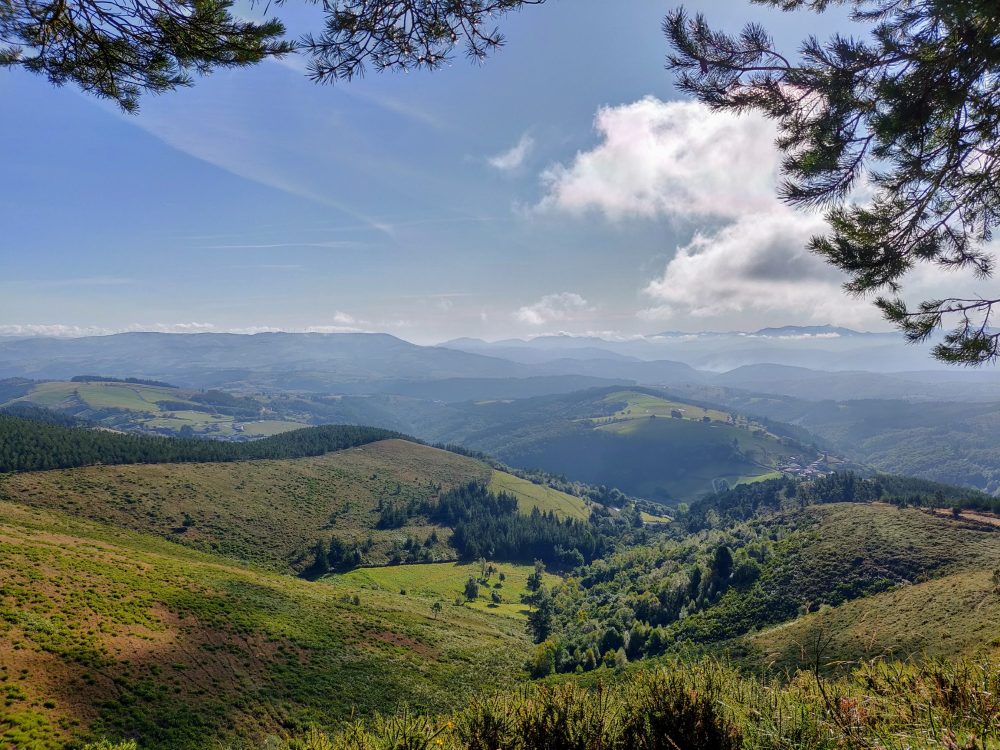
The weather had been clear the night before, and was just the same when we woke up before dawn. With no rain in the forecast, the decision made: we were taking the Hospitales route today.
What a great decision that turned out to be.
We were walking by 8am, after the world’s largest cup of coffee at the albergue bar. The staff were happy to open up the supermarket so we could grab supplies: mostly fruit, nuts, cured meat, and anything else with lots of calories in a small package.
The first 3km to Borres was flat and unexciting, but everything changed from the minute we took the Hospitales turnoff. The track turned uphill, and didn’t really flatten out again for several hours.
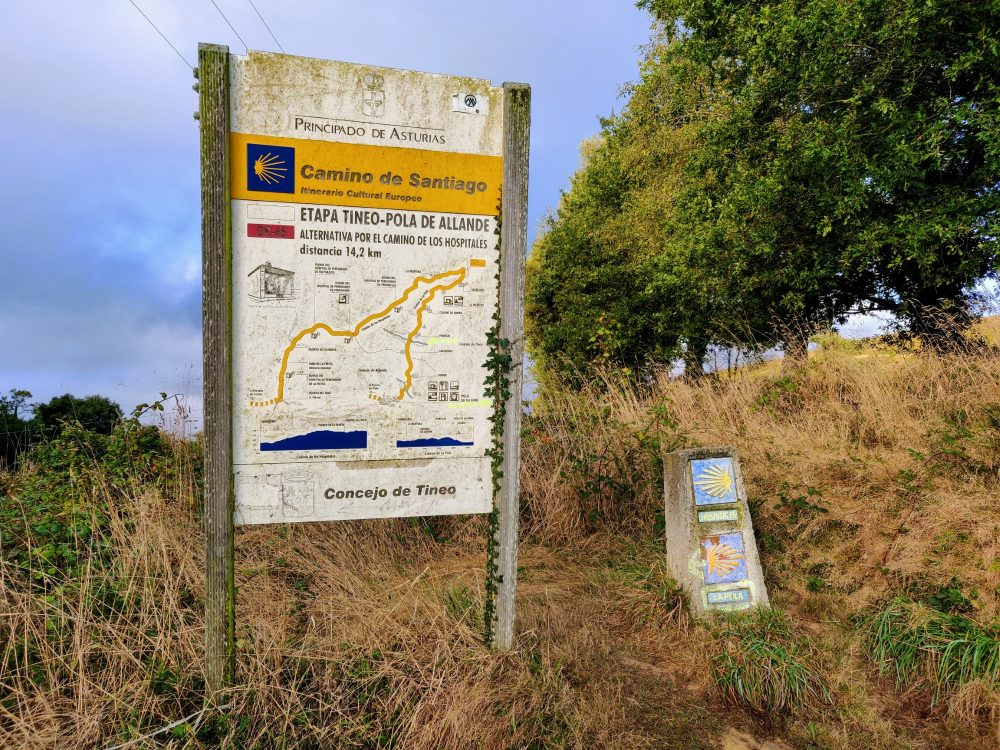
If my breath hadn’t been taken away by the climb, it would have been by the views. I know I’ve kept saying how good they were on previous days, but this was the pinnacle in every sense of the word — the point where the two routes converge is the highest on the Primitivo.
Before that, though, lay several kilometres of exceptional walking. There were few other people on the trail, usually seen from a distance, so it felt like we had this incredible stretch of countryside all to ourselves. The Hospitales route is often covered in cloud and fog, so having clear skies in every direction felt like a blessing from the Camino gods.
Taking one look at the steepness of the trail ahead, we stopped for a snack break beside the ruins of Hospital de Paradiella with only the cows for company. It was a beautiful spot, but just one of many throughout the day. Slogging our way up the hills, we swapped the cows for a herd of those awesome Asturian horses before finally getting to the ridgeline and the trail flattening out. Well, comparatively, at least.
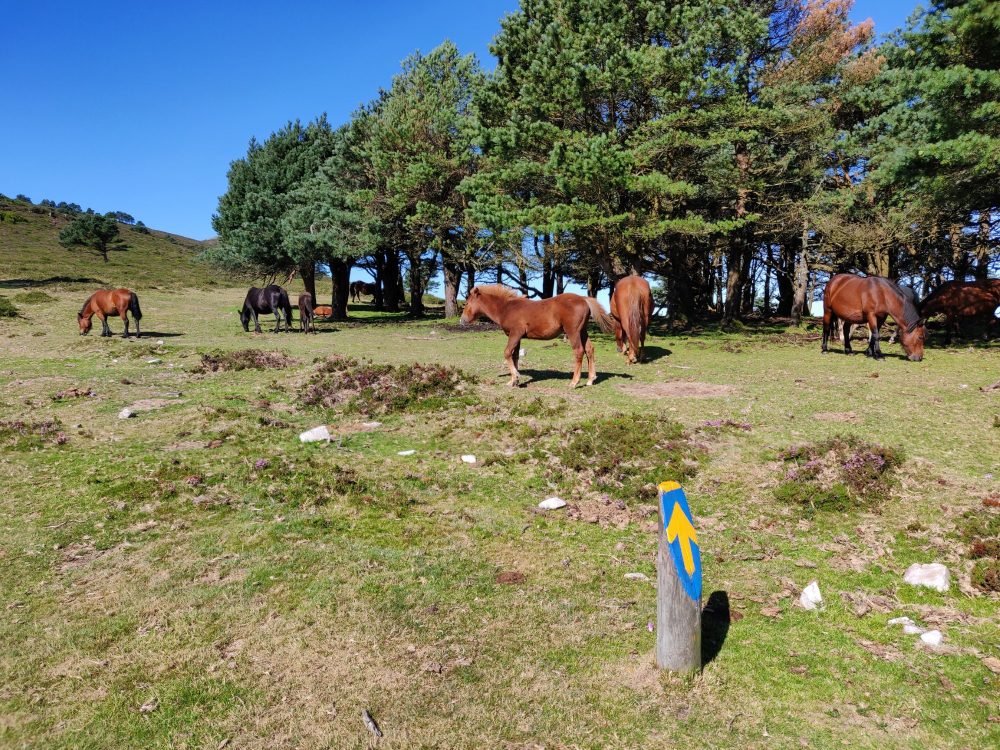
With no shelter from the wind any longer, the cooling breeze we’d had all morning became an icy blast whipping up the valley. I wasn’t sad about it — the sweat had been pouring off me — but on a different day, it’s not something I would have enjoyed walking in for hours!
The next section passed quickly, even with a lazy lunch break in a rare sheltered spot. The views, of course, were not getting any worse.
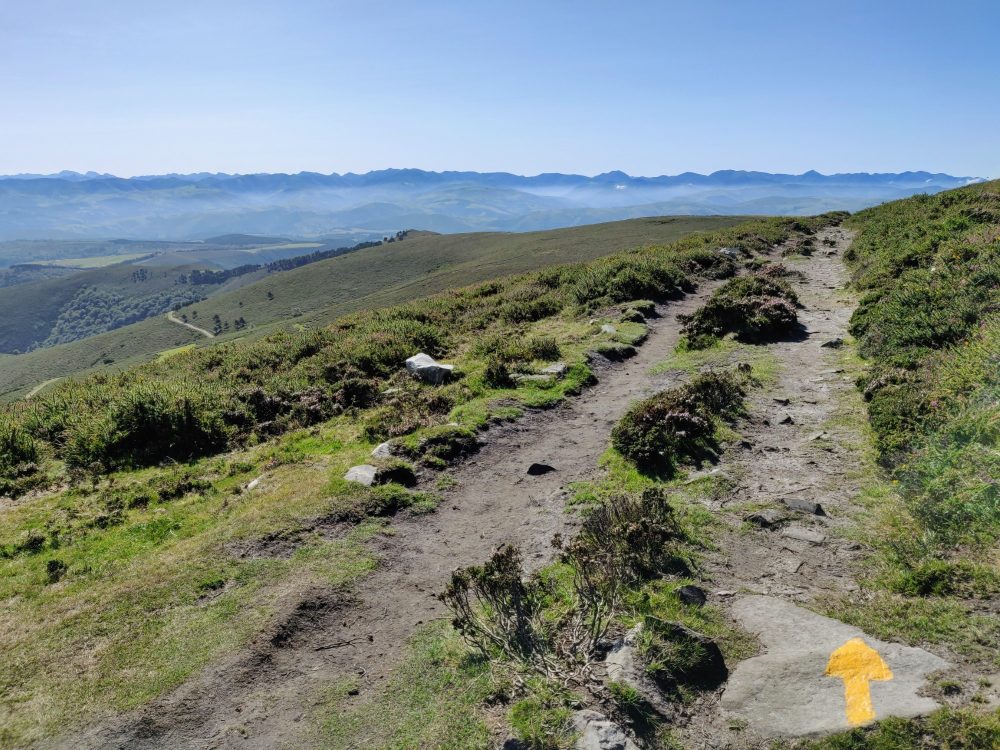
The upper and lower paths finally converged and for about half a second we thought the hardest part was over. And then we looked down.
The descent to the hamlet of Montefurado (population: one person, many cows) is around 300m over less than two kilometres, on a stony track that was very slippery in dry conditions. I can only imagine what it would have been like in the rain. As it was, Lauren spent more time on her butt than on her feet, and I was sorely tempted to be a human toboggan as well.
I ended up alongside the trail more than on it, where the ground was much more rough and uneven but at least I had some grip most of the time. Let’s just say it was not a fast descent for either of us.
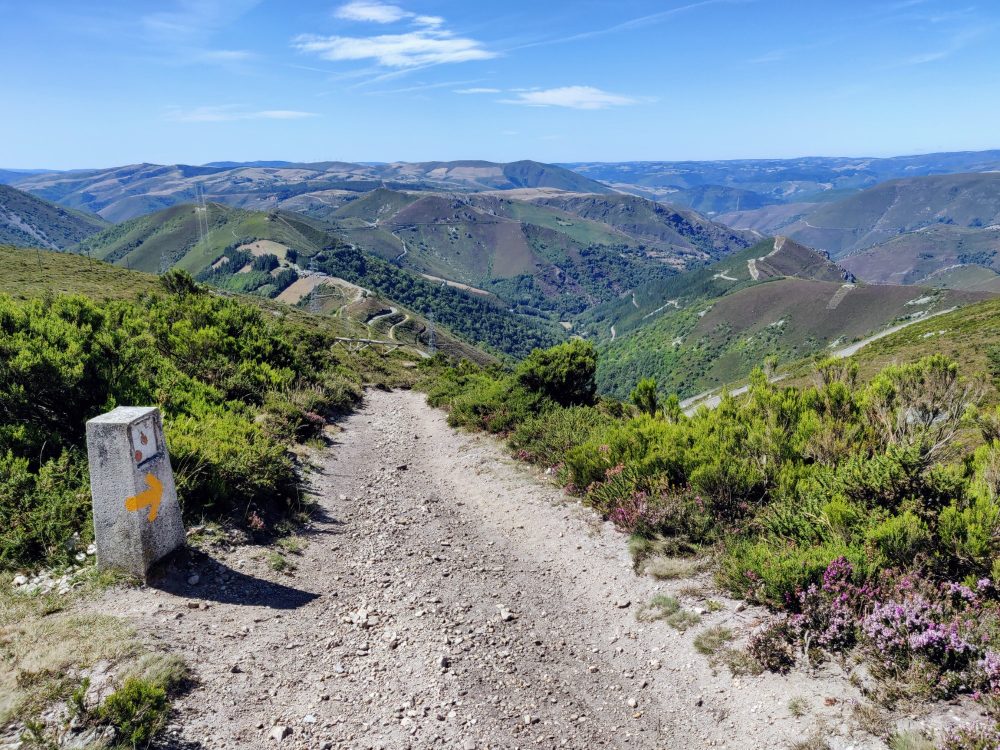
It was a long 7km from Montefurado to Berducedo, the first place with any accommodation, and while the descent and final walk through the forest were pretty enough, we were definitely ready to stop by the time we staggered into town in the late afternoon.
We’d noticed that the municipal albergue was closed for a refit on the way in, and when we saw a sign outside one of the other albergues saying the owners were on holiday, our chances of finding somewhere to sleep took a sudden nosedive.
Unsurprisingly all of the beds at the main bar/albergue in town were taken, and when we mentioned that to someone sitting outside, he said there were no beds in the next village (A Mesa) either. Hmm. I was starting to see taxi rides to somewhere off-trail in our very near future.
After wandering around fruitlessly for a while longer, a kindly local noticed our plight and pointed us toward Hostel Rural Camin Antiguo. The grumpy owner shouting down from her balcony demonstrated the truth of the bad online reviews, but while the dorm beds were all taken, she was happy to overcharge us for the last remaining twin room.
After nine hours and over 30km of walking, let’s just say budgetary concerns took a back seat. The room was nothing special, but it had a hot shower and non-lumpy mattresses. That’s all we needed, and it was certainly better than sleeping in a ditch on the side of the road.
We had drinks (several) and dinner (massive) back at the main bar, and collapsed into bed as soon as it got dark. What a day!
Total distance: 32.6 km (20.3 miles), twin room: 25€ per person
Day 6: Berducedo to Grandas de Salime
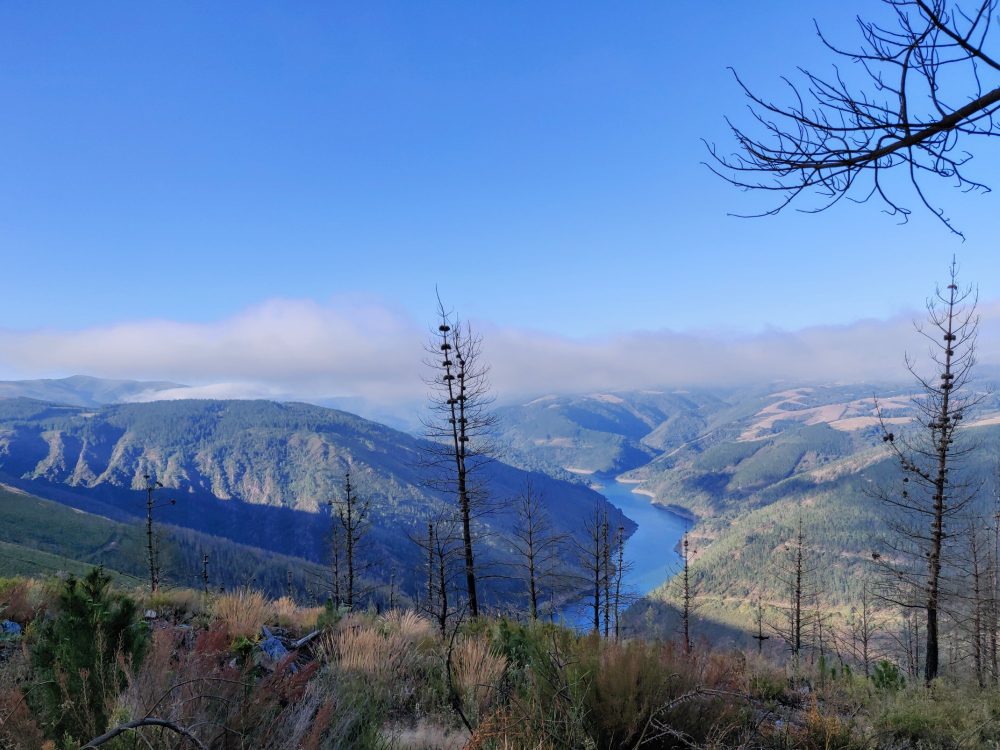
Helped by the lack of breakfast options at the only open bar in town the following morning, we were on the road just as the sun peeked over the horizon. Cool and mostly flat for the hour or so into A Mesa, it got warmer and much less flat immediately afterward.
Passing several wind turbines at the top of the lengthy uphill, thick cloud coated the valley below us. Dropping through it was quite eerie, not helped by the blackened stumps of trees all around us thanks to a large forest fire that ripped through the area back in 2017.
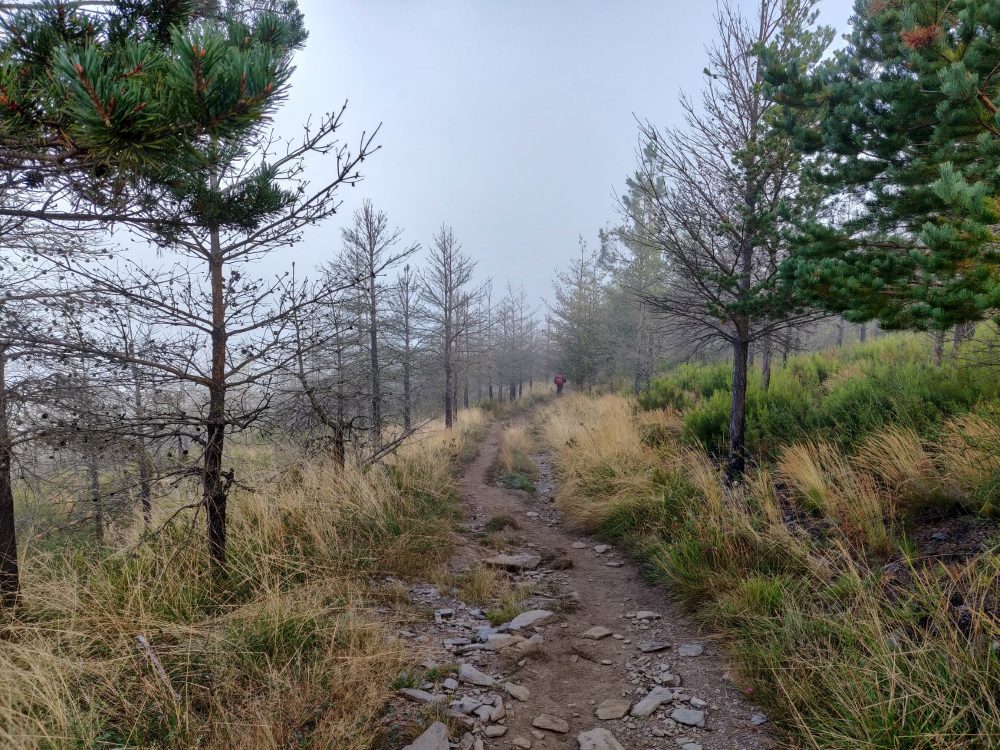
Once we got below the cloud layer, though, gorgeous views awaited. You used to be able to walk across the valley until 1954, when it was flooded as part of a hydro dam project. The walk is now much longer, since you have to walk across the dam itself, but at least you get scenic views while you do it.
It’s a long old descent from the top of the hill down the dam, dropping around 800m over the course of around 8km of switchbacked dirt trail. Steep in parts, it was still easier overall than the precipitous drop into Montefurado the day before, but my knees weren’t loving me by the time we finally got to the bottom and crossed the dam.
The crumbling infrastructure alongside wasn’t anywhere near as pretty as the reservoir itself, but on the upside, the terrace of the bright-yellow Hotel Las Grandas beckoned on the other side. Filled with other walkers, it had that friendly, buzzing Camino vibe I’d enjoyed on other routes but struggled to find so far on the Primitivo.
The views were lovely, the bocadillo was delicious, and the ice-cold Coke disappeared in about three seconds flat. You can spend the night there if you so desire, and I seriously considered it on the strength of that bread roll alone. It took a long time to find the motivation to keep moving.
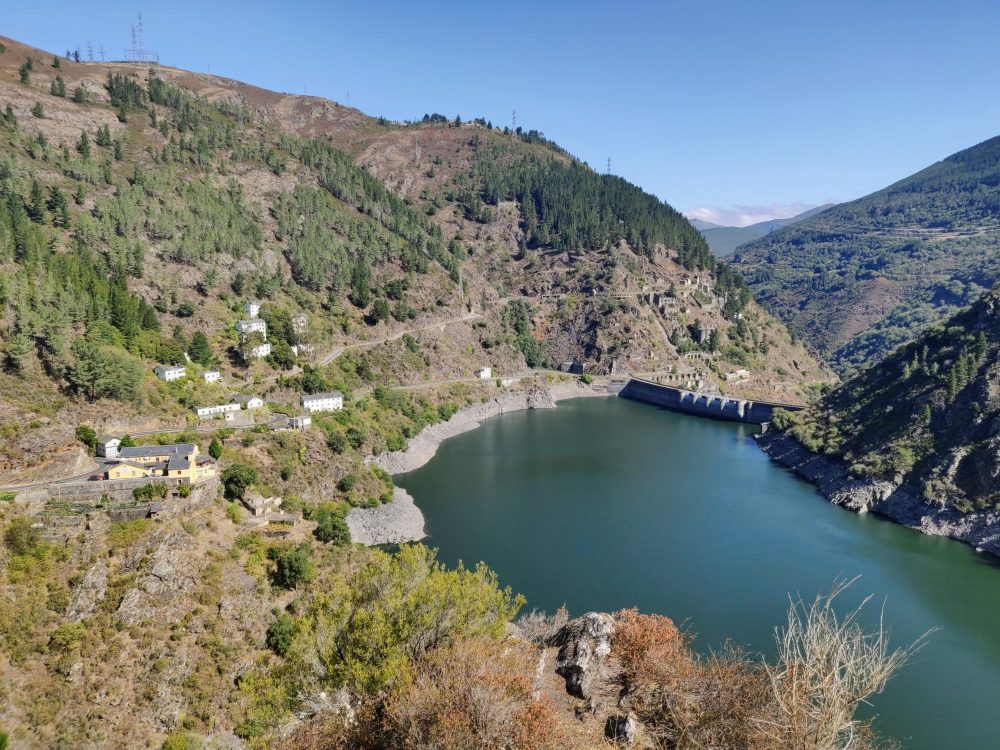
When we finally found it, we were rewarded by an uphill slog along the road almost all the way to Grandas de Salime. Not much of a reward really, but at least the town itself was nice, if pretty quiet on a Sunday afternoon.
We opted for the municipal albergue, which had the advantage of being cheap, and the disadvantages of large, cramped dorms and flooded bathrooms. Still, it had beds available, and for that we were grateful.
It had been a relatively short day, so we had plenty of time to kill. Most of that time was spent either eating, drinking, or lying in a park…which, lets be honest, is a pretty good way to spend any afternoon. Shoutout to the surprisingly good hamburgers for dinner at Cafe de Jaime.
Total distance: 24.2 km (15 miles). Bed in 12-person dorm: 6€
Day 7: Grandas de Salime to A Fonsagrada
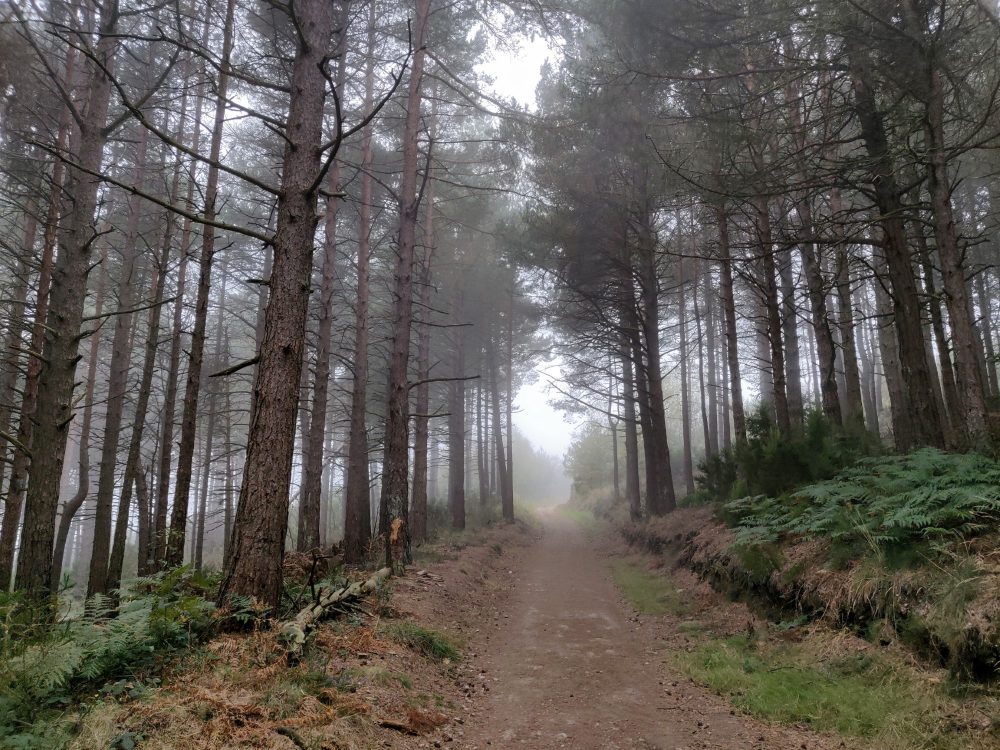
Given that the rest of our dorm room was made up almost entirely of large middle-aged male cyclists, there was less overnight snoring than I might have expected. Less doesn’t mean none, however, and when I leaned over the side of my bunk at 5:45am to see Lauren staring back at me, we decided to just get up and go.
Walking in the dark on any Camino is always an odd mix of enjoying the peace and tranquility, and a continual mild concern that you’ll miss an arrow and end up miles off-trail. As I learned, having a GPS map on your phone does wonders for the latter and leaves more head space for the former.
The sun didn’t start to come up until just outside the village of Castro, where I’d half-expected to find a bar serving breakfast. If it existed, I didn’t spot it. No coffee for me, but at least the road walking of the previous hour gave away to softer trails. That was welcome, even if the thick fog and steep climb was less exciting.
The fog was so thick that I almost missed the tiny bar at O Acebo at the top of the pass. Lauren was a bit behind me at this point, and actually did miss it. Luckily she realised after a few minutes and backtracked, otherwise we’d probably still be searching for each other to this day.
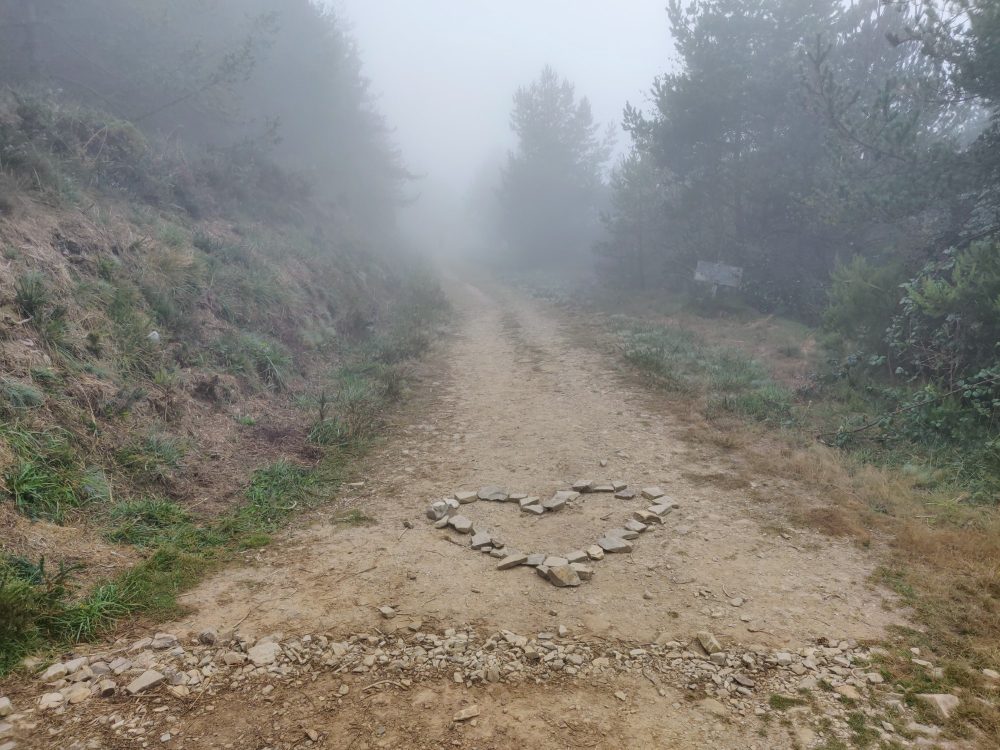
Having crossed from Asturias into Galicia shortly before, it was time for my first Santiago tart of this Camino. This almond-based cake is common in this part of Spain, rare outside it, and one of the few desserts I can eat (no lactose!) As a result, if I see it on the menu, there’s a good chance I’ll be ordering it.
Washed down with a strong coffee, and with the bar now full to the brim with other walkers, we headed back out into the gloom. Not for long, though: like the day before, we descended below the cloud layer and into sunshine for the rest of the walk.
Despite the long climb and descent, the day had felt relatively easy overall as we approached Fonsagrada. Lucky, then, there was one final steep ascent to get up into the town. The Camino Primitivo: There’s Always a Hill. If that’s not the official slogan yet, it should be.
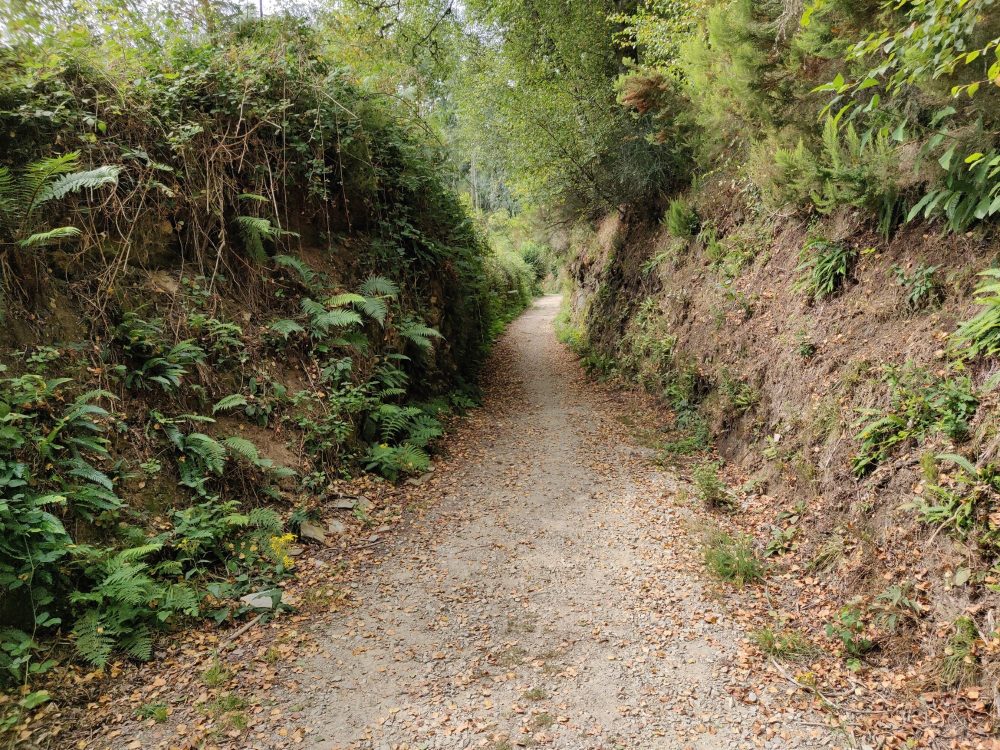
Due to that early start, we arrived in Fonsagrada around 1pm and headed to the lovely-sounding Canterbrico albergue and pension. Apparently we weren’t the only ones who thought it sounded nice: despite being the first walkers to get there that day, every bed had already been reserved. Half a dozen backpacks that had been transported by van sat neatly lined up beside the door awaiting their owners.
The staff member was nice enough to call one of the other places in town, Casa Manolo, and confirm there was a double room available there for us. The change of plans wasn’t a big deal, but helped make up my mind about booking ahead for the rest of the walk, at least for smaller villages. The bed race was real. Sigh.
The room at Casa Manolo was plain, but the shower was exceptional, and the restaurant downstairs did a decent pulpo (octopus)-based pilgrim menu for 15€. Small victories.
Wandering around the town afterward, we ran into a group of Italian, Spanish, and Swiss guys on the street that we’d vaguely got to know over the last few days, and stood around chatting about nothing and everything for ages. Slowly but surely, the Camino vibe was starting to grow.
Total distance: 26.7 km (16.6 miles). Double room: 20€ per person
Day 8: A Fonsagrada to Cadabo
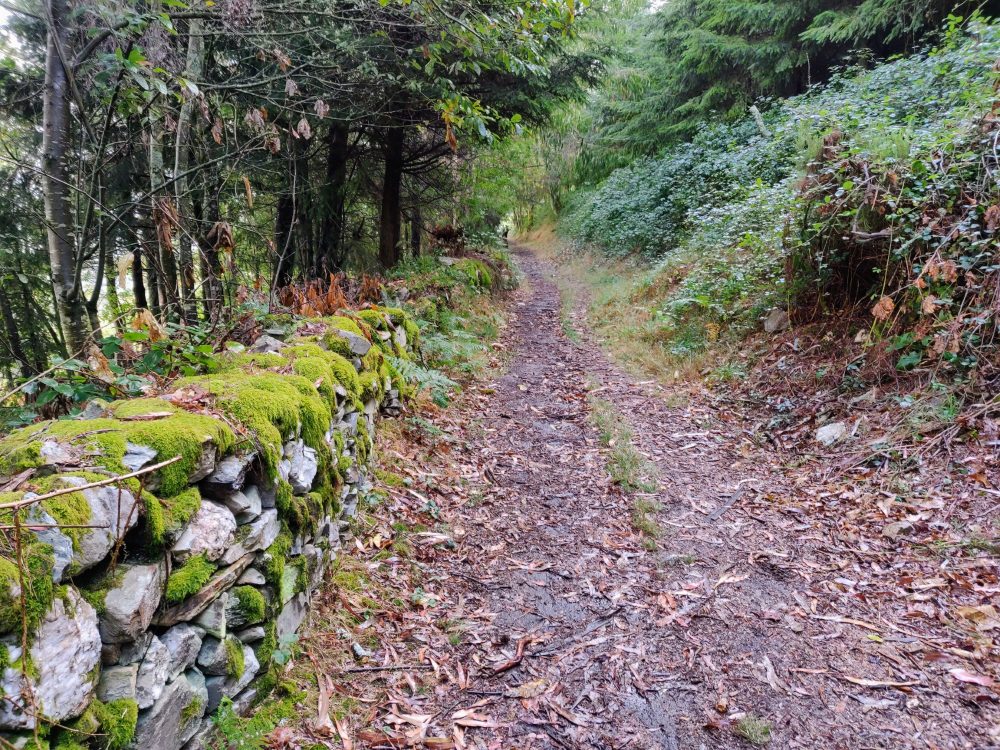
Today was my birthday, and after waking up in the night to heavy rain, it had looked like my present was going to be getting soaked for eight hours. Luckily the downpour turned into more of a light drizzle by daybreak, which came and went all morning. Cloud, sun, wind, rain, rinse and repeat.
We left Fonsagrada just before dawn, walking through damp woodland for a while before starting a long, mostly gradual climb through the forest. With the weather changing every five minutes, it wasn’t unusual to climb up one side of a hill in sunshine, and be hit by rain and a howling gale on the other. Fun times.
At the top of the rise lay a cluster of wind turbines. Given that I was being almost blown off my feet at the time, it didn’t take much imagination to figure out why they’d been put there. Right alongside lay the remains of a medieval pilgrim hostel, the crumbling stone walls a stark contrast to the gleaming white turbines behind them.
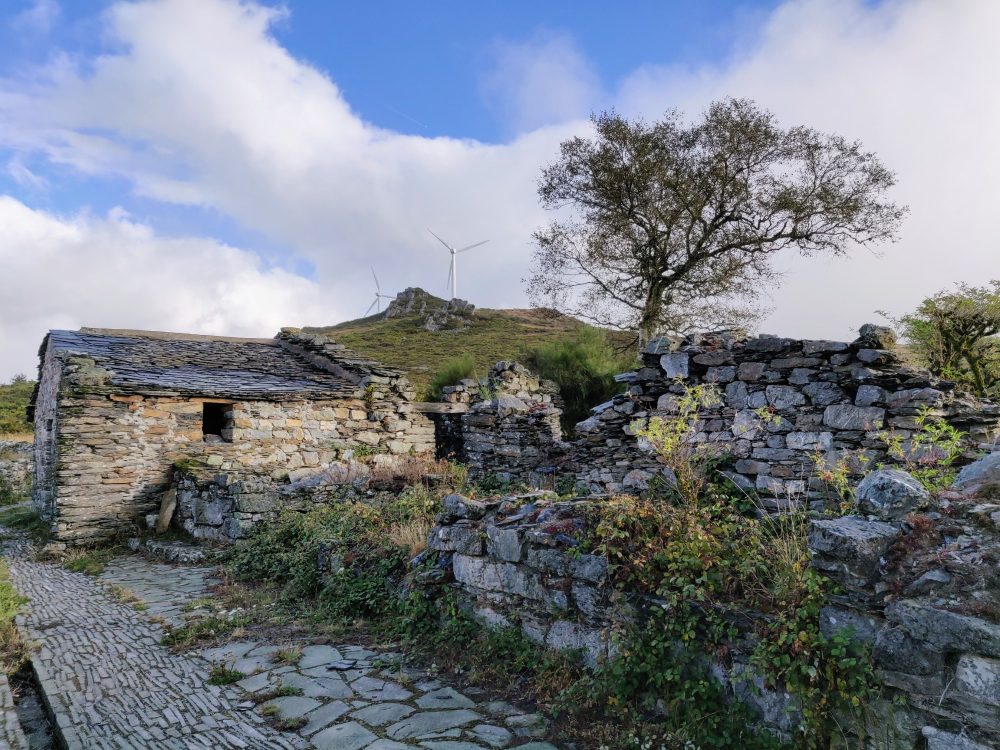
The descent from the top was straightforward but long, and by the time we approached the Casa Meson bar at Paradavella, my stomach was definitely rumbling. Full of other walkers, the staff were doing a great job of taking orders, slinging coffees and soft drinks left and right, and keeping everybody fed and watered.
Fresh bread had been a rare luxury on the trail in Asturias, but we were in Galicia now, and things were different. Very different. My tuna and olive bocadillo was the tastiest (and probably, largest) lunch I’d had in a week. There was no way that Lauren and I needed one each. We ordered one each anyway, and didn’t regret it for a second.
The temperature dropped and the rain came back as we were finishing up, which was all the incentive we needed to keep moving. We were both shivering as we set off, but the long, steep uphill soon afterward dealt with that problem. Up, down, up, down, it’s the Primitivo way.
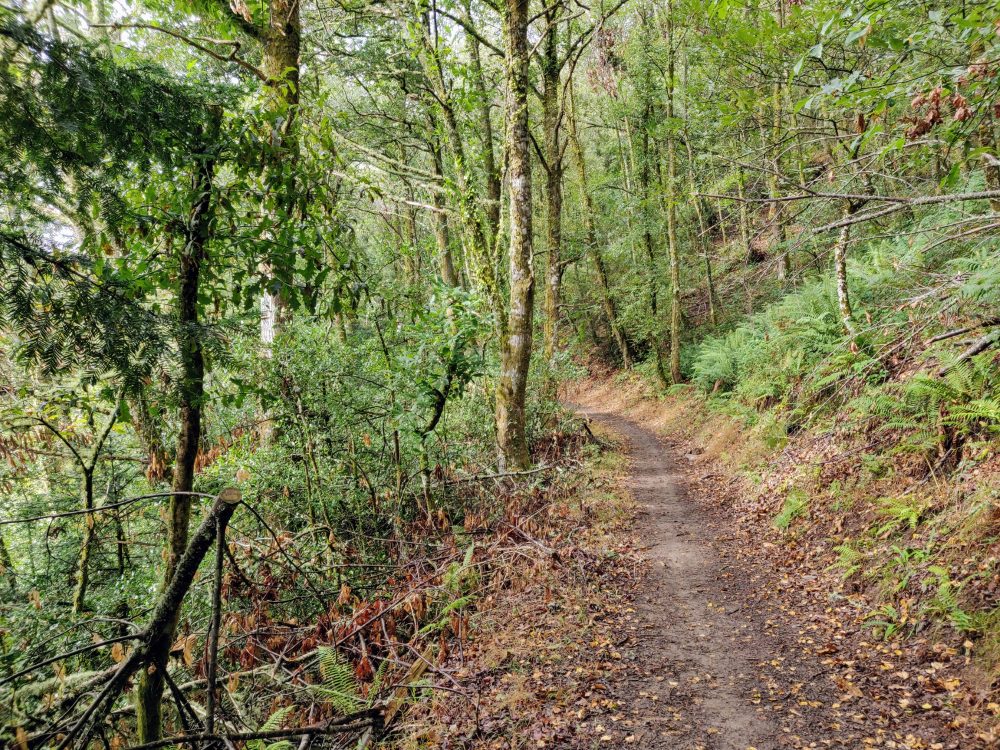
The weather stayed unpredictable during the afternoon as well, although at least there was a bit more sun and a bit less rain. We arrived in Cadabo around 2.30pm, walking past the municipal albergue that was apparently already full. Because of course it was.
Luckily we’d booked a room at Albergue San Mateo (I didn’t plan to celebrate my birthday by sleeping in a barn), which followed the trend of being plain, perfectly serviceable, and offering much more sleep than a dorm! The shower was nicer than the room itself, which was a bit unusual.
Sitting outside in the fleeting sunshine with a bottle of cider, I contemplated another birthday on the Camino. This was the second time I’d done it (the first was on the Frances when I turned 40), and it was hard to think of a better way to celebrate.
The weather soon clouded over again, so after a ten-minute wander to explore the highlights of Cadabo (there weren’t many), it was the usual Camino combo of a pilgrim menu dinner at the albergue restaurant and an early night.
Total distance: 26.3 km (16.3 miles). Double room: 17.50€ per person
Day 9: Cadabo to Lugo
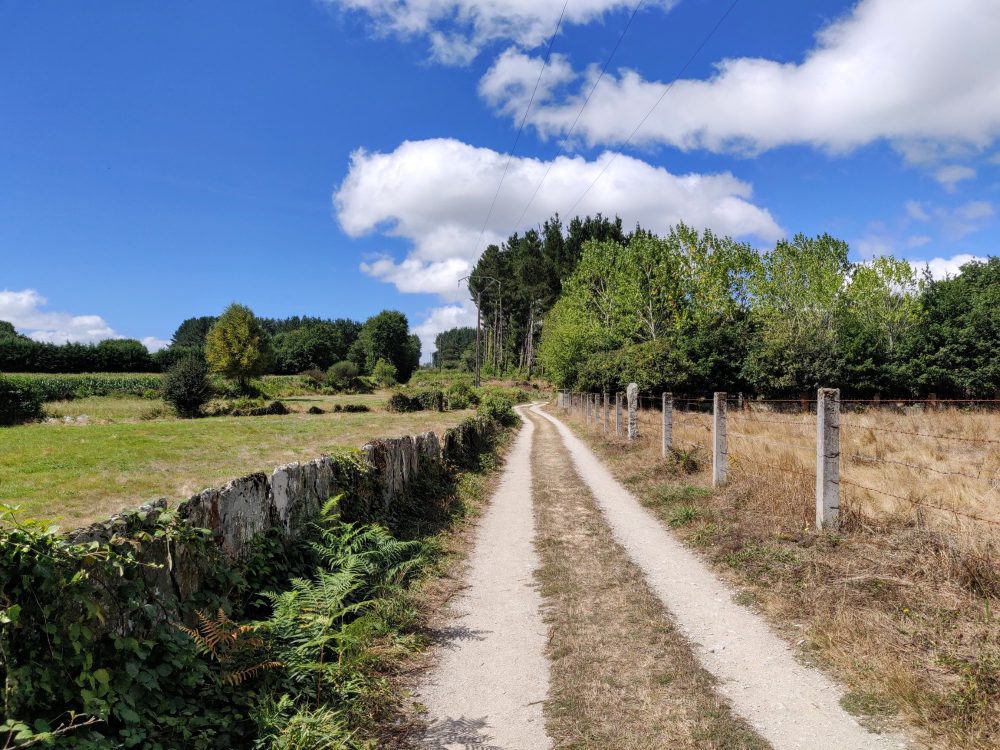
Coffee for breakfast again, and out into the early-morning mist around 7:30am. We met Cailyn on the way out of town, a fellow walker from Seattle who’d walked half the Camino del Norte before dropping down onto the Primitivo. With almost everyone else we’d met being Spanish or Italian, finding a fellow native English speaker felt like a rare treat, and we chatted all the way to a breakfast stop in Castroverde nearly two hours later.
A couple of Danish guys she knew showed up shortly afterward, and we sat around slurping coffee and swapping hiking stories for ages. Nobody was in a hurry to move on, and so for nearly an hour, nobody did.
The mountain section of our Primitivo was now over, and it showed. The trail was much flatter and easier today, but also less pretty, with most of the walking being through farmland and tiny villages. We made good time, helped by there being hardly any services for the 22km between Castroverde and Lugo: just a vending machine in the middle of nowhere, and an outdoor cafe beside an albergue in Vilar de Cas with coffee, cold drinks, and cake.
Coming into a proper city like Lugo was a shock after several days of small towns and villages, but our fancy accommodation was an even bigger surprise. Lauren’s birthday present for me was a night at Puerta de San Pedro, and the crisp linens and well-dressed clientele were quite the contrast to lumpy dorm beds and stinky hikers like us.
Lugo itself was an attractive city, with fortified Roman walls that stretch around the entire old town. I amused myself by wandering around the inner city and on top of the walls for a while (apparently the 30km I’d walked to get there wasn’t enough…), until I was waved over to an outdoor table in the main square by a few other hikers we’d got to know along the way. The wine flowed, the tales got ever-less believable, and the pain in my feet disappeared for a couple of hours. Good times.
Not used to having more than two options of where to eat for dinner, we dawdled around for ages trying to decide before ending up in Cafetaria Abrente, a little outside the city walls. Just like the restaurant in Tineo several days before, it had zero ambiance, impressively-good food, and friendly staff. I’d go back in a heartbeat.
Total distance: 30.1 km (18.7 miles). Double room: 37.50€ per person
Day 10: Lugo to San Romao
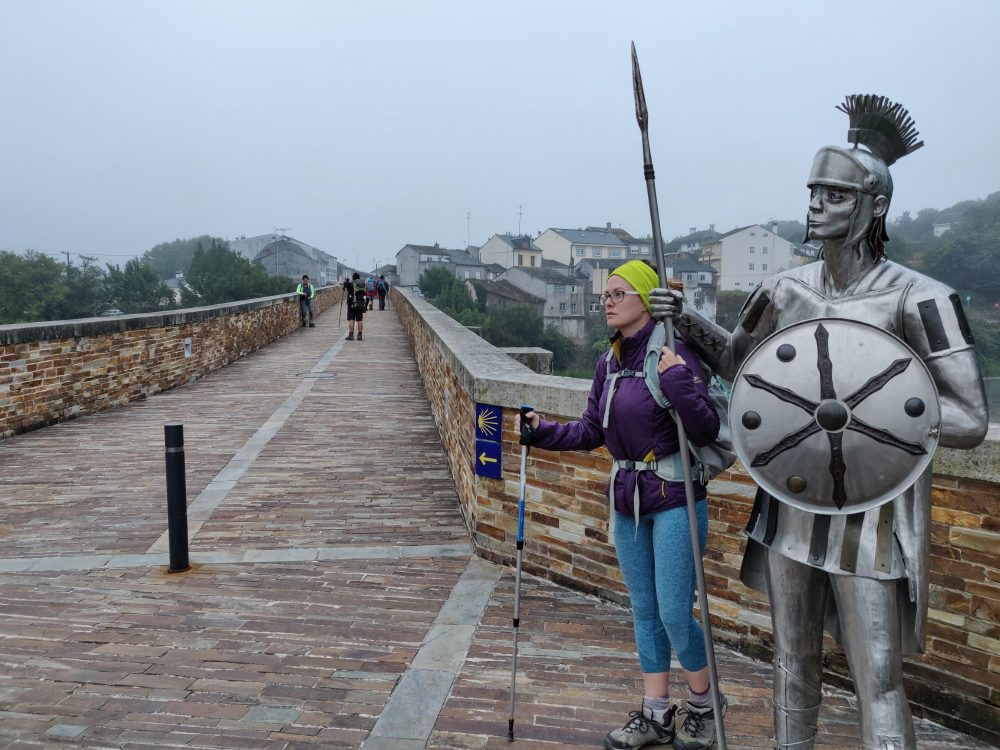
After eating far too much of the breakfast buffet at the hotel, we set off into the mist around 8am. Signs and shells guided us past the cathedral, over the Roman bridge, and up a steep hill (of course) as we headed out of town.
After a week and a half, this was the first day of the Primitivo spent mostly walking on the road rather than soft trails. That’s a much better ratio than the other routes I’ve walked, but even so, the hard surface took its toll on our feet and knees. The fog had burned off by mid-morning, and the idea of a long, hot day on tarmac became less appealing with each passing step.
There were still a few highlights, of course, including the mid-morning snack at the fanciest vending machine I’ve ever seen (set in its own little shelter with a bathroom, microwave, seating area, and Google Maps rating printed out and stuck on the wall), and the traffic jam caused by a dog cheerfully leading his flock of sheep down a country lane.
We hobbled into Albergue O Candido in the tiny hamlet of San Romao early afternoon, to find pretty much everyone we’d met along the route sitting outside eating lunch.
Some of them were staying the night there, others were continuing on a bit further, but our throbbing feet combined with the hammocks and very large glasses of wine on offer sealed the deal for us. A short day it was going to be!
A long snooze in the hammock answered the question of what I was going to do with the rest of my afternoon, followed by dinner and drinks with some acquaintances who quickly became friends. It had ended up being a really social day all around, and that coupled with the short distance made it particularly enjoyable. Yay!
Total distance: 20.2 km (12.6 miles). Double room: 17€ per person
Day 11: San Romao to Melide
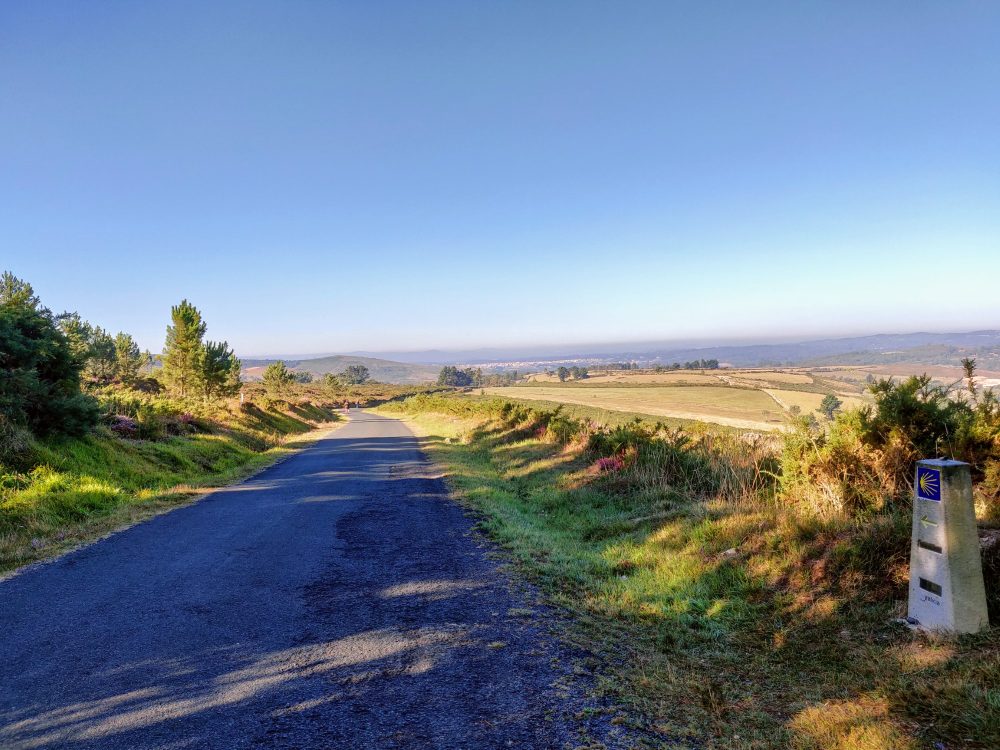
With little in the way of accommodation between Lugo and Melide, a shorter day yesterday inevitably meant a longer day today. We expected it to be hot and full of road walking as well, and in the end it lived up (down) to all three expectations.
Starting out early to try to beat at least some of the heat, we were walking by 6:45am. It was the right decision, with two or three hours of quiet, cool conditions before the sun really got going. There was nowhere open for more than a drink all morning, but I really liked the donation-based coffee and homemade art stall in a tiny hamlet somewhere around the 10km mark.
The day heated up super-fast after that, just in time for the occasional gravel and dirt trails to disappear completely in favour of asphalt and concrete. Great. We stopped for a snack in the last of the shade, shortly after spotting Melide from the top of a small hill.
It didn’t look all that far away, but we knew it was at least 10km, and felt every single minute of the 2+ hours it took to get there. The final slog through the suburbs was particularly tough, with no shade and sweltering heat reflecting from the road and concrete buildings.
Melide is where the Camino Primitivo joins up with the Camino Frances, and it couldn’t have been more obvious. Having seen no more than a hanful of other walkers for the last 11 days, we walked into the city to what felt like a near-riot of other pilgrims. I’m sure it was no worse than when I’d walked the Frances myself four years earlier, but the sudden change was pretty jarring this time around.
With plenty of accommodation in Melide there’d been no need to book somewhere in advance, and we picked Albergue Pereiro at random. It was a good choice, with modern, near-new double rooms out the back and plenty of space in the outdoor courtyard.
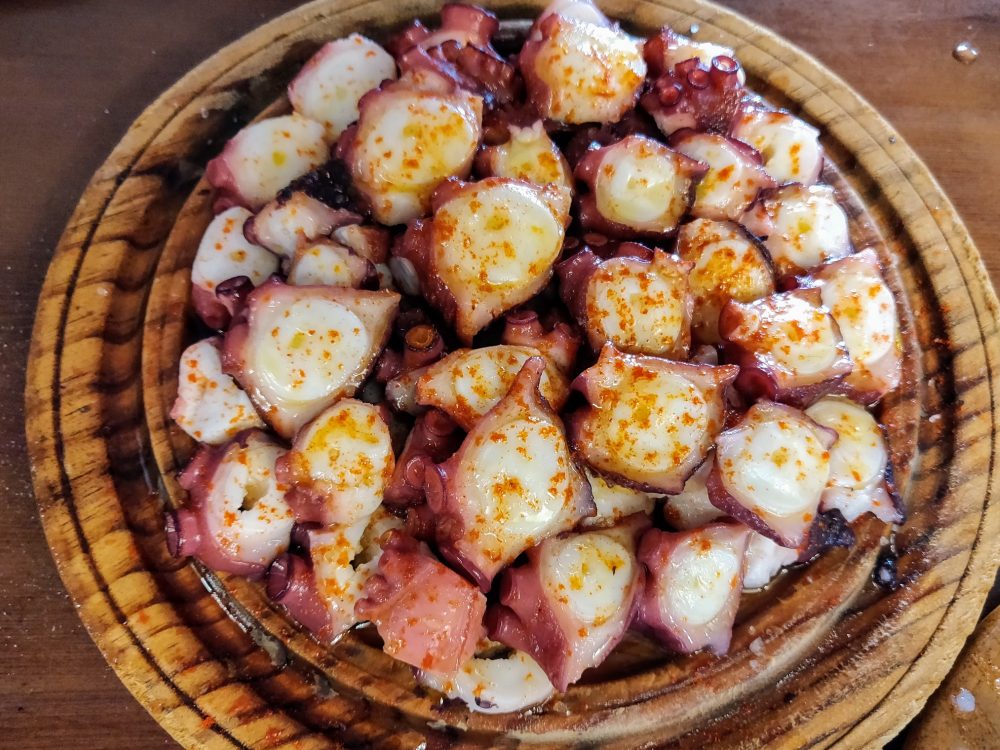
What I was most excited about, however, was a return visit to Pulperia a Garnacha. Done right, Galician-style octopus is incredibly delicious, and the pulpo at Garnacha is definitely done right.
I’d eaten a huge plate of the signature dish at this restaurant four years earlier, and I was determined to introduce Lauren to its delights. She’d heard me go on about it for nearly half a decade, after all.
Luckily for both of us, it was just as good as I remembered. Washed down with wine, plus plenty of bread and boiled potatoes to keep the carb levels high, we’d walked in starving and left full to bursting. If you like octopus and find yourself in Melide, you really need to eat here.
Total distance: 27.8 km (17.3 miles). Double room: 20€ per person
Day 12: Melide to A Brea
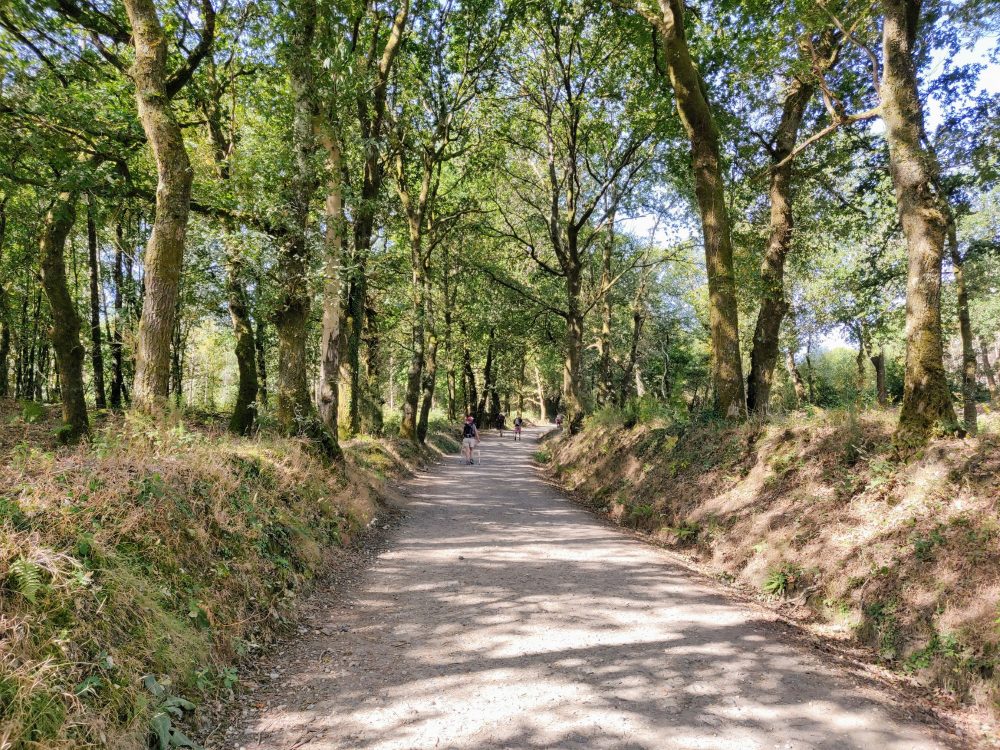
With another hot day in store, we were up early to make the most of the cool pre-dawn conditions. Inevitably, then, we left our hiking poles behind at the front door as we exited the albergue via the (self-locking) rear gate. Cue half an hour of waiting around in the dark for someone else to leave so we could get back inside to retrieve them. Sigh.
With that out of the way, we strode purposefully out of town. For an hour or so, at least, until we arrived in Boente and saw El Aleman, a stylish German albergue and cafe that looked brand-new and was advertising breakfast. The coffee was good, the bread was even better, and the owner was super-friendly. Say what you will about the Frances route, but it’s well set up for walkers.
I’d remembered a lot of road walking on the final couple of days from Melide, but apparently my memory is fading in my old age. There definitely wasn’t as much as I’d expected, but the next couple of hours into Arzua were still a bit of a slog, especially towards the end when the sun was out in full force.
Arzua is quite a large town, but not a particularly attractive one along the main street. Still, that’s where the arrows point, so that’s where we went. After stopping for a Coke at what I’m almost certain was the same cafe I stopped at for the same thing four years earlier, we pushed on into some woodland and welcome shade.
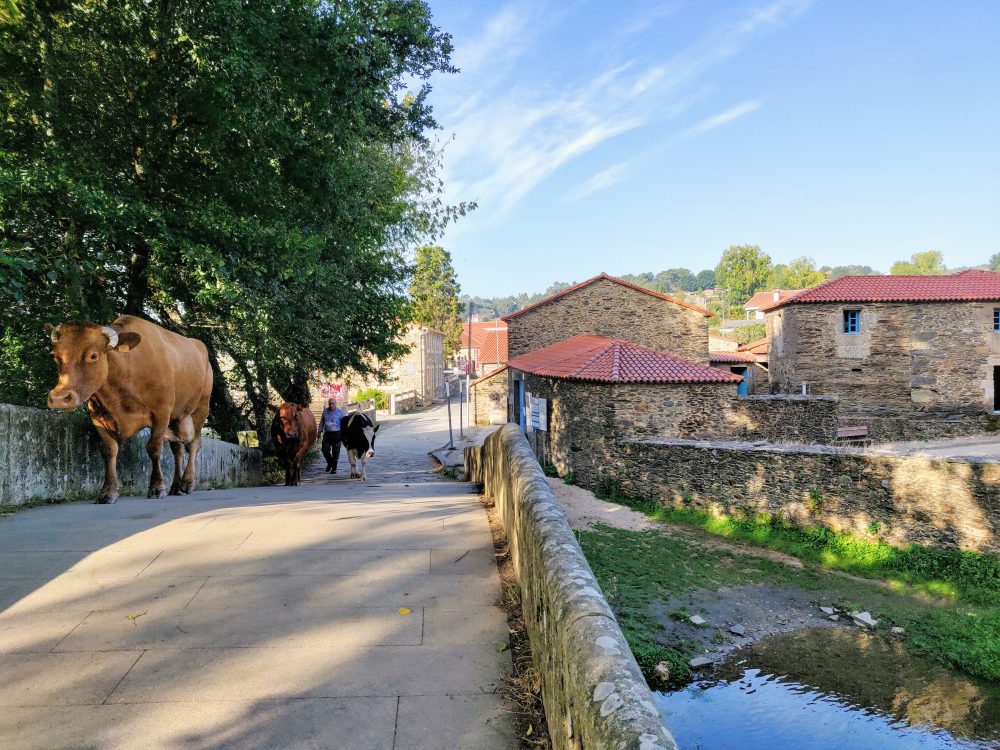
After a close encounter with some cows and a surprisingly-good bocadillo for lunch at Bar Lino just outside Outeiro (any excuse to get out of the sun for a while), we spent the afternoon wandering slowly toward A Brea. I’d hoped to get a little further, but the promise of a swimming pool at Pension ‘The Way’ lured us in.
In the end the pool was freezing, but the outdoor setting was lovely and the large glasses of wine even lovelier. Our double room with shared bathroom was a bit overpriced for what it was, but the husband and wife that ran the place were friendly and helpful, and cooked up a mean group dinner for the dozen or so walkers staying there. Highlight: home-made coffee liqueur to finish. I don’t know what was in it, but it was delicious!
Sadly this place didn’t survive the pandemic, and has now closed down. It’s a shame–I’d definitely recommend staying there otherwise!
Total distance: 27.8 km (17.3 miles). Double room: 22.50€ per person
Day 13: A Brea to Santiago
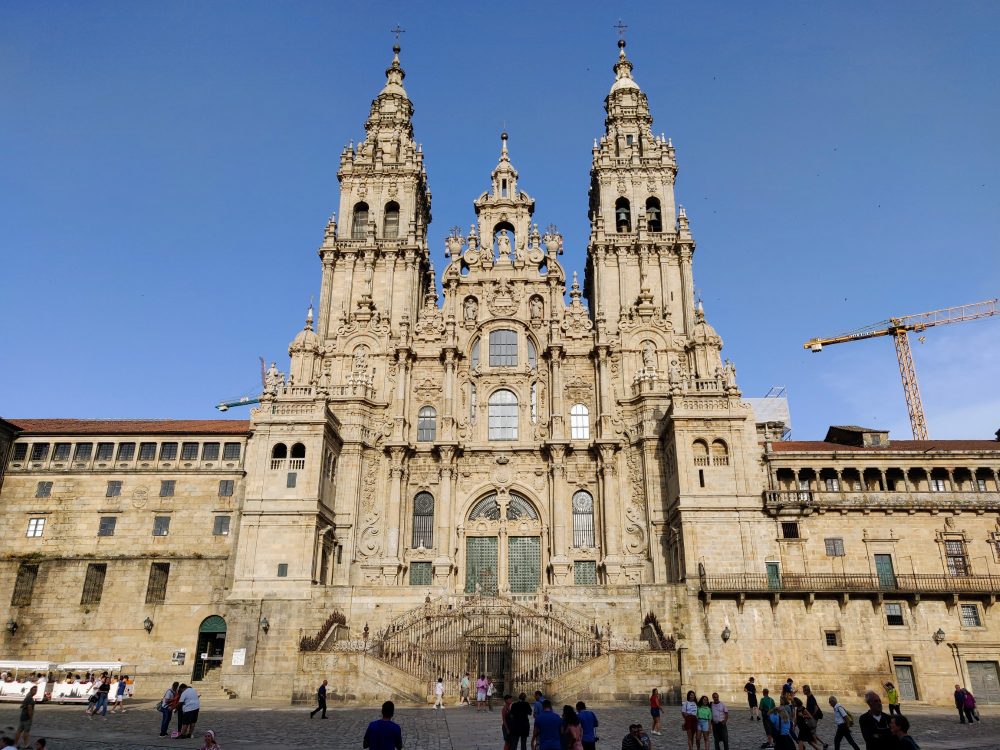
Our last early start, and another one of those cool, clear mornings that makes walking before dawn so worthwhile. The volume of other walkers and cyclists grew steadily all day, in terms of both numbers and sound, as the final rush to the cathedral took over.
Before that, though, lay a couple of hours of soft trails and quiet woodland. Being a Sunday, several of the cafes and bars were closed, so it took a while until we found a roadside bar in O Pedrouzo for breakfast. Fortified by carbs and strong coffee, we pushed on past the chain link fence surrounding Santiago airport and back into the forest.
It’s funny how close the airport seems to the city when you’re taking a bus between them, and how far apart they seem on foot. Grabbing a quick lunch in Lavacolla alongside several dozen other walkers, it was time for the final uphill of this Camino.
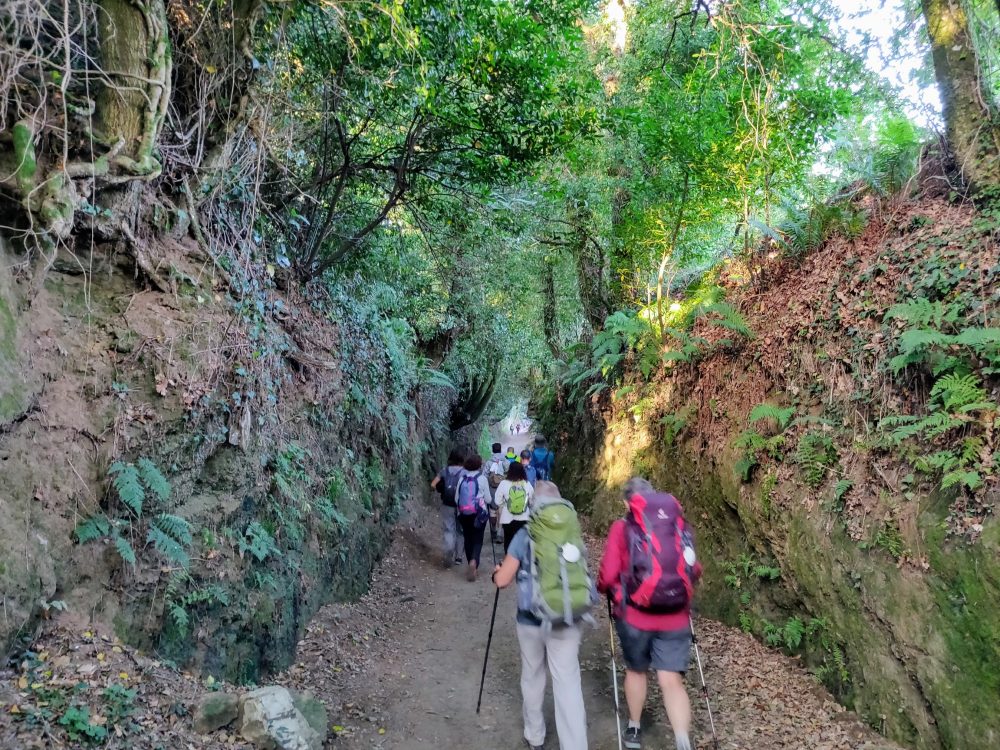
Topping out at Monte de Gozo, a small hill overlooking Santiago with a large pilgrim monument at the top, we grabbed a drink from the nearby kiosk and savoured the view. You can’t quite see the cathedral from there, but the end was very much in sight.
Down the hill and through the eastern suburbs we walked, and the hour of concrete monotony was just as hot, ugly, and dull as the previous time. Entering from the south, which you do on the Portuguese route, is a far nicer experience. Even so, the excitement was palpable as we joined the stream of pilgrims walking through the heart of the city.
The sound of Galician bagpipes filled the air as we walked through the final archway and out into Praza do Obradoiro. Turning to face the cathedral was breathtaking, even moreso than my other Caminos because the scaffolding that had covered the front for many years was no longer there.
Somehow we’d managed to finish just a few minutes after all of the friends we’d met along the way, who called us over and pressed cold cans of beer into our hands. Just like that we had our Camino family, exactly when we needed it.
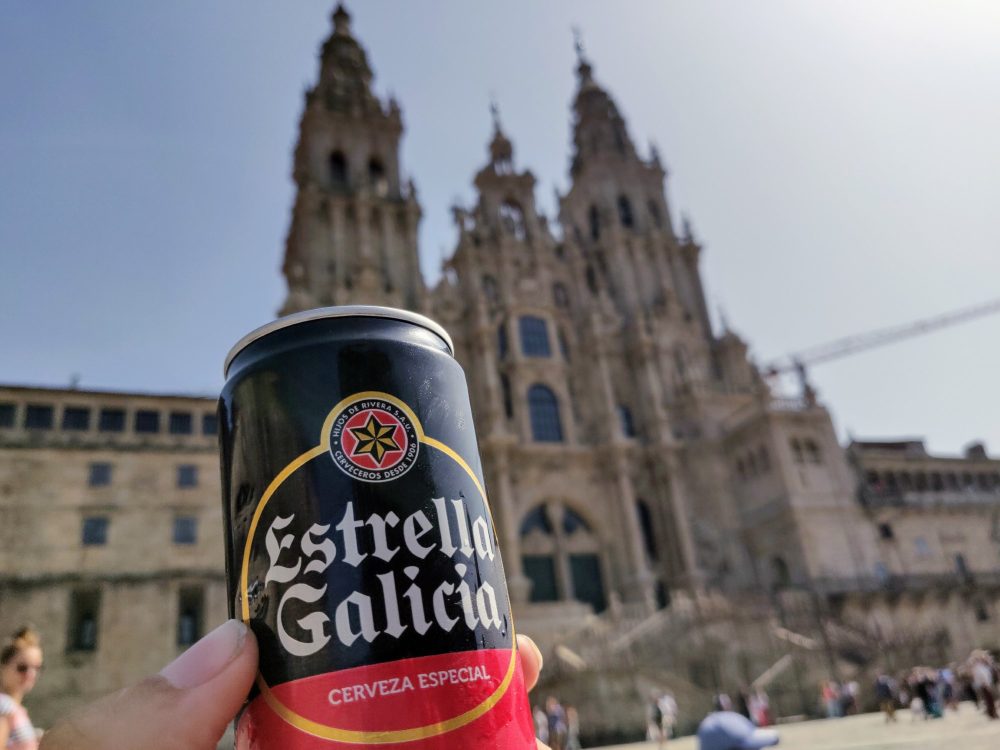
Lauren had declared several times in the previous two weeks that she’d never walk another Camino, but in that moment in front of the cathedral, everything changed. Within minutes she was planning a solo month on the Frances. The Camino is addictive, even if you don’t realise it until right at the end!
We sat sipping our beer and basking in the sunshine, finally with nowhere else to go and no more walking to be done. Promising to meet up again for dinner, the group eventually broke up an hour or so later, and we limped our way back to the lovely Stellae Luscofusco.
It’s slightly further out of the centre than some of other accommodation, but as a result, much better value for money in a city that’s not exactly renowned for it.
Our last Camino meal was everything we might have hoped for, even if it did take a bit of wandering to find somewhere with space for us all. Platefuls of food filled the table, our wine glasses were never empty, and laughter filled the little square we were sitting in.
Tomorrow our multicultural group would split up and start heading for all corners of the globe, but tonight it was the Camino that united us all.
Total distance: 26.3 km (16.3 miles). Double room: 23€ per person
Final Thoughts
So overall, how would I rate the Camino Primitivo?
In so many ways, it was fantastic. The mountains and forests of the first week or so in particular were exceptional, with seemingly every climb (of which there were many) rewarding with spectacular views to the horizon. Walking along the woodland trails for hours was a delight, whether the trees were dripping from recent rains or casting welcome shade from the hot sun.
The walking was hard at times, due to the mix of long days, steep hills, and comparatively few places to stop along the way. That’s the kind of difficulty I like, though, much better than the blister-filled, knee-busting hardship of endless cobblestones, concrete, and asphalt you’ll find on the other northern Caminos.
We had wonderful weather, on a trail that’s not known for it. Waking up to clear skies most mornings was a welcome relief, and let us make the most of those exceptional views. On the odd occasion it did rain during the day, it was usually light and only for a few hours. Nothing my poncho couldn’t handle!
Before Melide (and especially before Lugo), there were few other walkers. That didn’t mean there were no problems with accommodation (as mentioned, this is the only Camino where I’ve booked rooms ahead of time) but it did mean plenty of peace and quiet to appreciate the beautiful surroundings.
That lack of fellow pilgrims, though, did mean it took longer to make friends than on my other Caminos. If you’re not an extrovert like me, you may view that as a bonus, but I can’t say that I did. Still, it’s at least partially my own fault: if I spoke more than very basic Spanish, it would have happened much faster.
The food was also a bit of a letdown, at least prior to Melide. We never starved (quite the opposite), but mealtimes were usually more about calorie replenishment than gastronomic delight. Asturias has a proud food culture, but we didn’t find much evidence of it along the Primitivo route. The wine, however, was always drinkable and in plentiful supply.
If that’s all I have to complain about, though, it really isn’t much. When it comes to summarising how I feel about any long walk, in the end it boils down to one simple question: having done it once, would I do it again?
In the case of the Camino Primitivo, it’s quite simple. Yes. I definitely would.
Got any questions about walking the Camino Primitivo? Leave them in the comments and I’ll do my best to answer them!

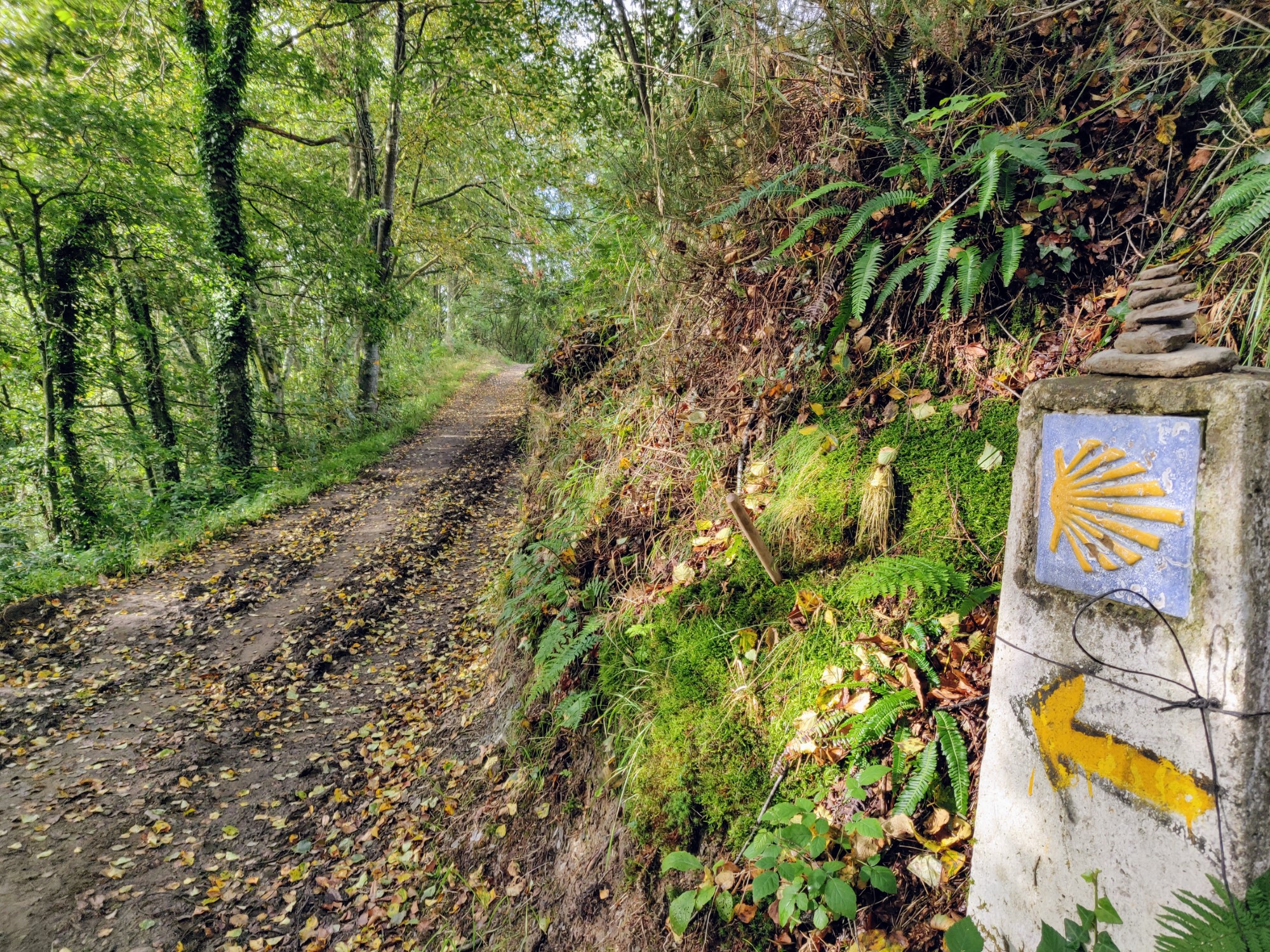
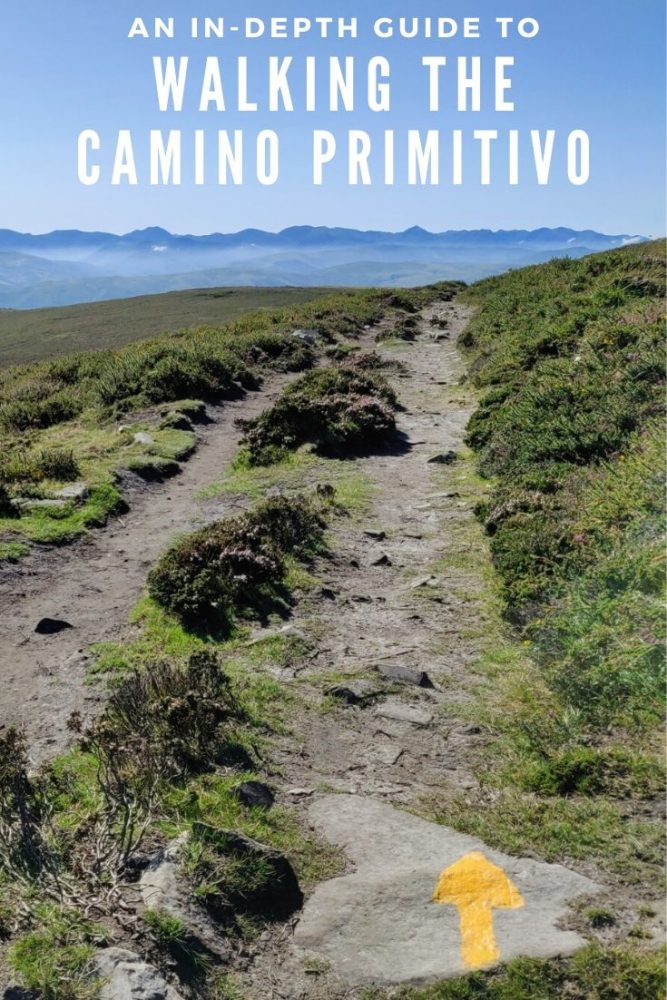
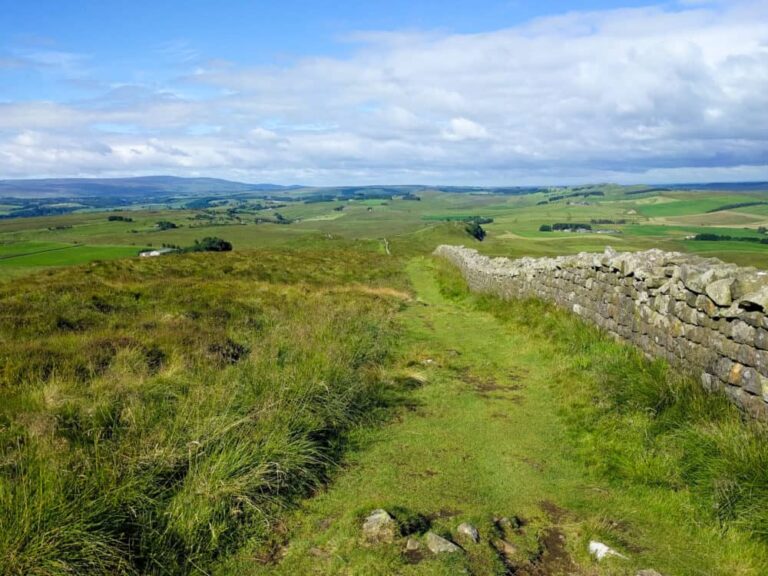
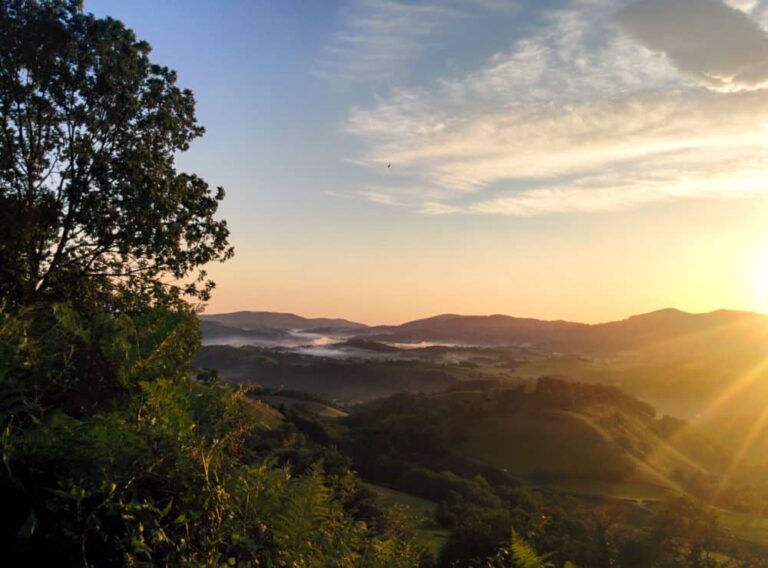
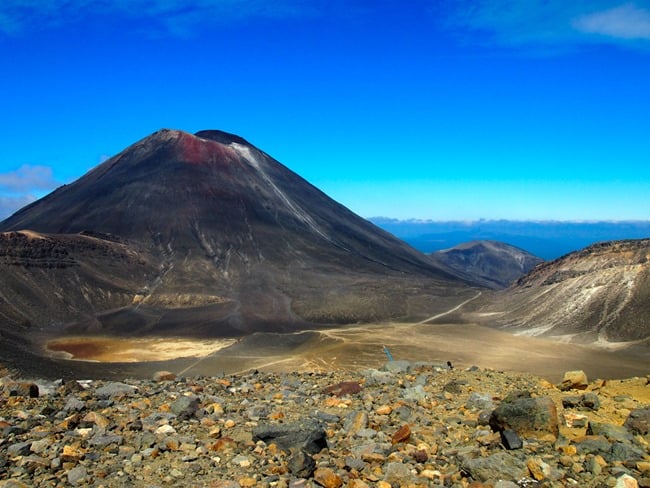
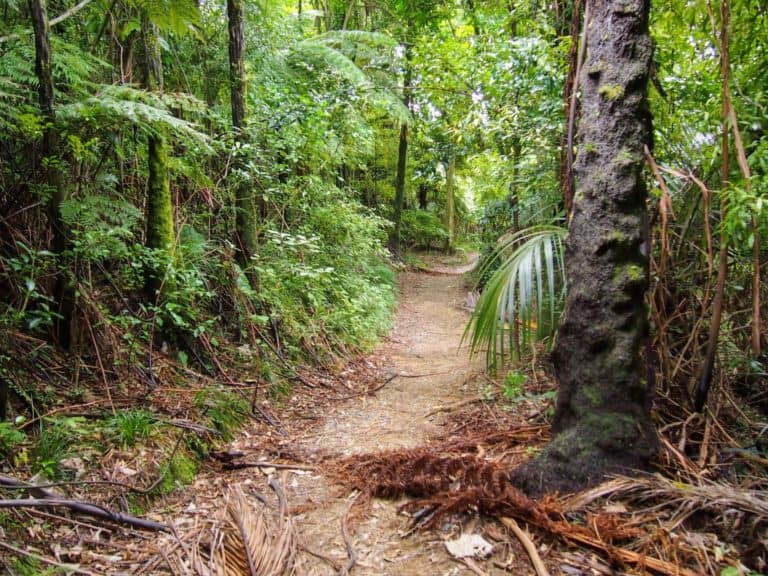
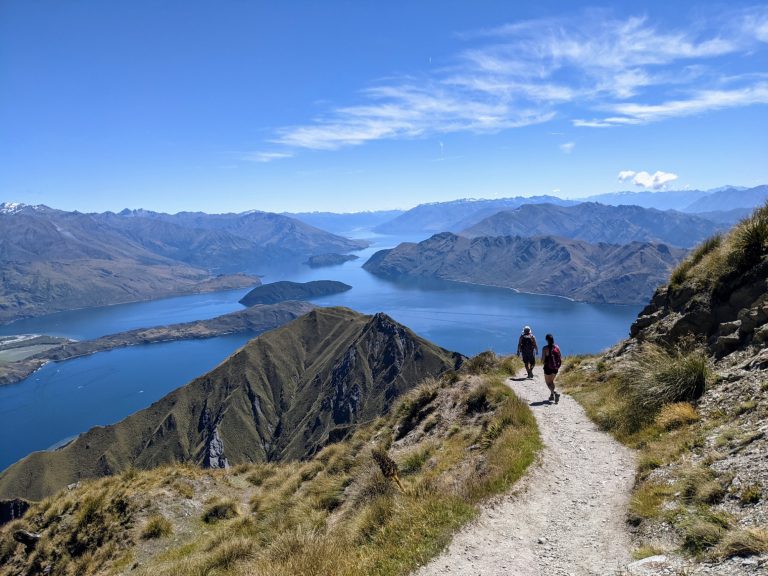
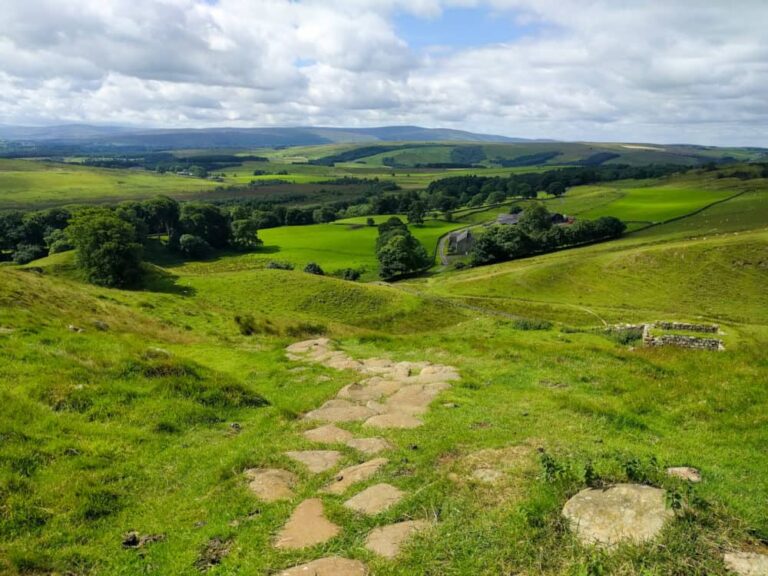
Thanks for the great info.
More than welcome, Robert! 🙂
Good Morning from Ontario, Canada, I enjoyed your blog immensley even though when I travel I don’t walk 20+ km a day and I enjoy non touristy spots but your destinations and routes are far from what I would ever even try to do at the age of 56…BUT saying that I so enjoy your details and account of your trips, I live a bit through blogs such as your seeing those parts of the world that I will never see….in the last few years I have enjoyed Portugal twice, Croatia, Belgrade, Brussels, Budapest and several other wonderful destinations…(touristy) type places are not my thing although I am a people watcher. I do appreciate the detail you provide in your blig and it makes someone like myself who lives in NW Ontario appreciate the beautiful scenery that is 1/2 way around the world. Stay safe and I hope that your future travels are soon.
hello there
After finishing Hadrian’s wall path last weekend I am wondering if the Camino Primitivo will be my next challenge. I like the idea of a less crowded Camino, as I am an introvert and enjoy my own company. But the experience of HWP was very demanding on my feet for just 6 days so I assume that 14 days of going up and down must be even more demanding. Thank you for your invaluable advice and ideas.
Best Blog I have read yet on the Camino experience. It gave me a really good sense of what to expect (and to expect the unexpected).
In the past I have mostly done Himalayan treks in Bhutan, but having done many of them I was looking for other similar types of adventures and the various Camino’s seemed interesting. Primitivo will probably be my first as I prefer the less congested types of treks (Hence why I love Bhutan).
I was interested to hear that your lack of Spanish fluency didn’t get in the way too often. My Spanish is limited to ordering beer and basic food at this time.
Thank you for sharing!
Did you meet any wild animals on the way? Do you think it is dangerous to do El Camino alone, as a woman? 🙂
The wildest animals I met on the Primitivo were a few wild horses. While the Primitivo is probably one of the more “remote” routes by Camino standards, there’s still very little in the way of wilderness.
I don’t think the Camino routes I’ve done (Frances, Portugese, and Primitivo) are particularly dangerous to do as a solo woman. Obviously I’m not a woman myself, but I met many women who’d walked some or all of these routes largely solo, and none of them mentioned anything about being afraid or encountering dangerous situations along the way. Unless you’re walking a long way outside the peak summer season, you’ll almost always meet other Camino walkers each day, and can choose to spend as much (or as little) time with them as you like if you’re feeling concerned about being by yourself.
Could bad things happen on the Camino? Yes, they could — but that’s true of everyday life as well, and I don’t think it’s really any more risky.
Thanks for a great and detailed description, very helpful as I prepare to walk the Primitivo this spring. I appreciate your balanced and appreciative account. Your discussion of the Hospitales option is particularly thought-provoking, inviting and appropriately cautious. I’ll take your advice to heart as I get there.
Peace….
I lived on my grandmother house in LA Montana de Illano for a few years back in the 70’s and I am certainly sure of what this Camino is like. However I am going to go for it this May some 60 years later. I know the terrain and the weather, but I think along with my Spanish and Gallego I should be able to at the very least enjoy some of the gastronomic foods that Asturias and Galicia have to offer. I shall go back to the farm to visit family after this trek and I hope that I will have the energy and stamina to complete this small feat. Thank you for your insight Dave much appreciated.
Thanks Tony. It’ll be super interesting to see what your experience is like, 60 years later!
I stumbled upon your blog while searching for elevation gain on the Primitivo. I begin in Oviedo on 15 Sept. I have a Village to Village guide that has the early stages plotted a bit differently than yours. I like yours better and think that I will start out using your stages. Thanks for the insight on the terrain and the helpful tips about albergues and food. I have a bed in Oviedo and on in Lugo, but nothing else yet I am hoping to wing until Melide. This will be my third solo Camino; the first was the Frances and last year the Portuguese Coastal so I have a pretty good idea of what’s ahead of me.Buen Camino.
Ahh, so jealous you’re waking the Primitivo! Glad you found the post useful, and hope you have a fantastic couple of weeks!
Thanks for this helpful guide! I’m getting a later start than I intended, but looking at an end-of-October/November Camino Primitivo 🙂 Hope the weather is kind & enough hostels are still open.
Buen Camino! Hope it works out well for you 🙂
Your guide to the Camino Primitivo is great! I’m thinking about doing it myself, and your tips are really clear and easy to understand. Thanks for sharing all this helpful info!
HELLO. This was an awesome review containing numerous tips. I am planning to take this journey this August. This will be my 4th Camino – French and Portuguese’s x 2. However, the other pilgrimages were much different in that I was walking with 2 others staying in pre-arranged accommodations and having luggage forwarded. From your thoughtful narrative, my goal to bust out of the tourist model and embrace the peregrino. The primitivo seems to impose this on the adventurous spirit – at lease on the Via Hospitalis route et al. Thank you for taking the time putting this together. I
No problem at all — glad you found it useful! I think you’re right, in that the Primitivo was (at least when I walked it) quite a different experience in terms of landscape and demographic to the Frances and Portuguese, and certainly more remote (especially around the Hospitales section) than either of them. I’m sure you’ll have a blast!